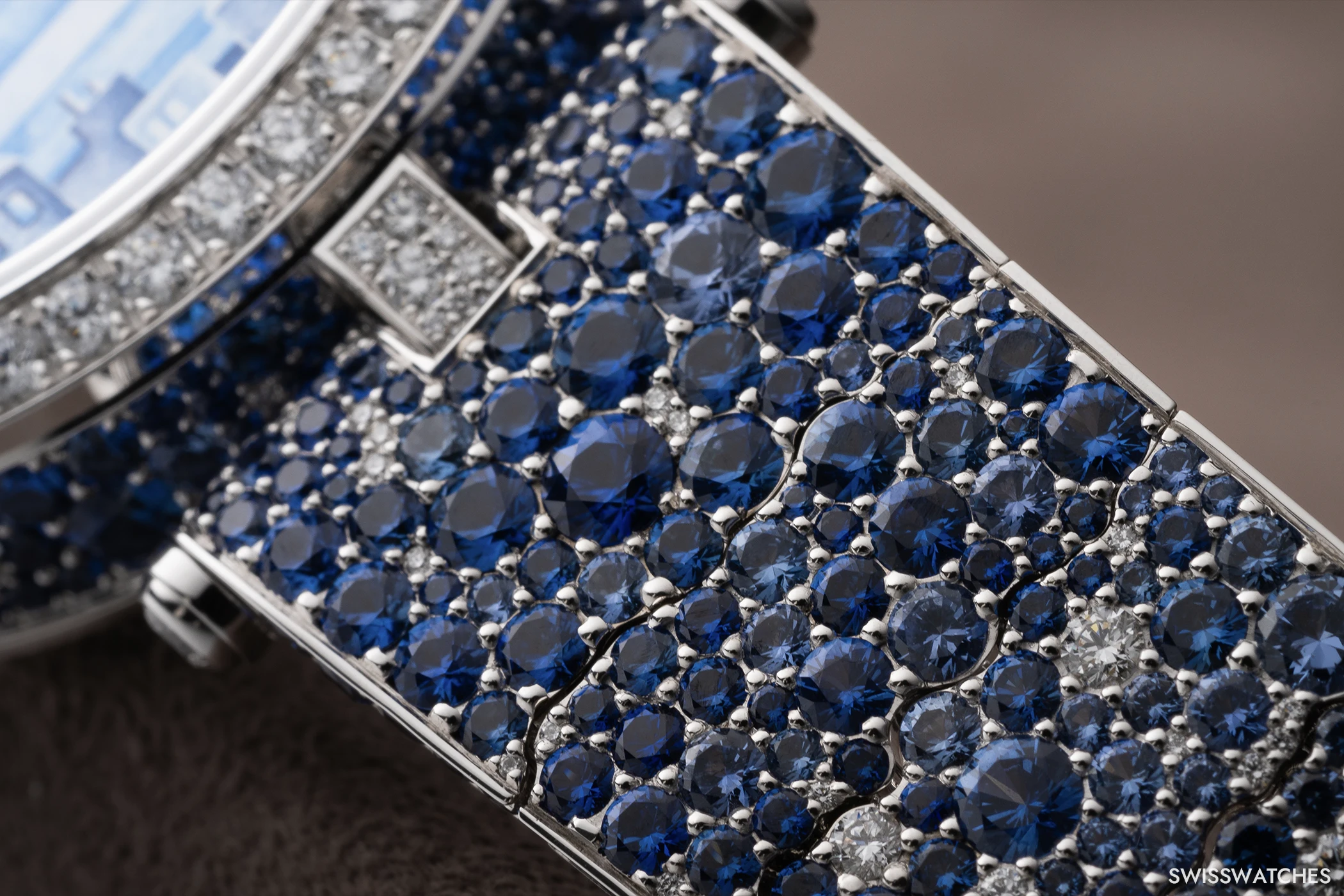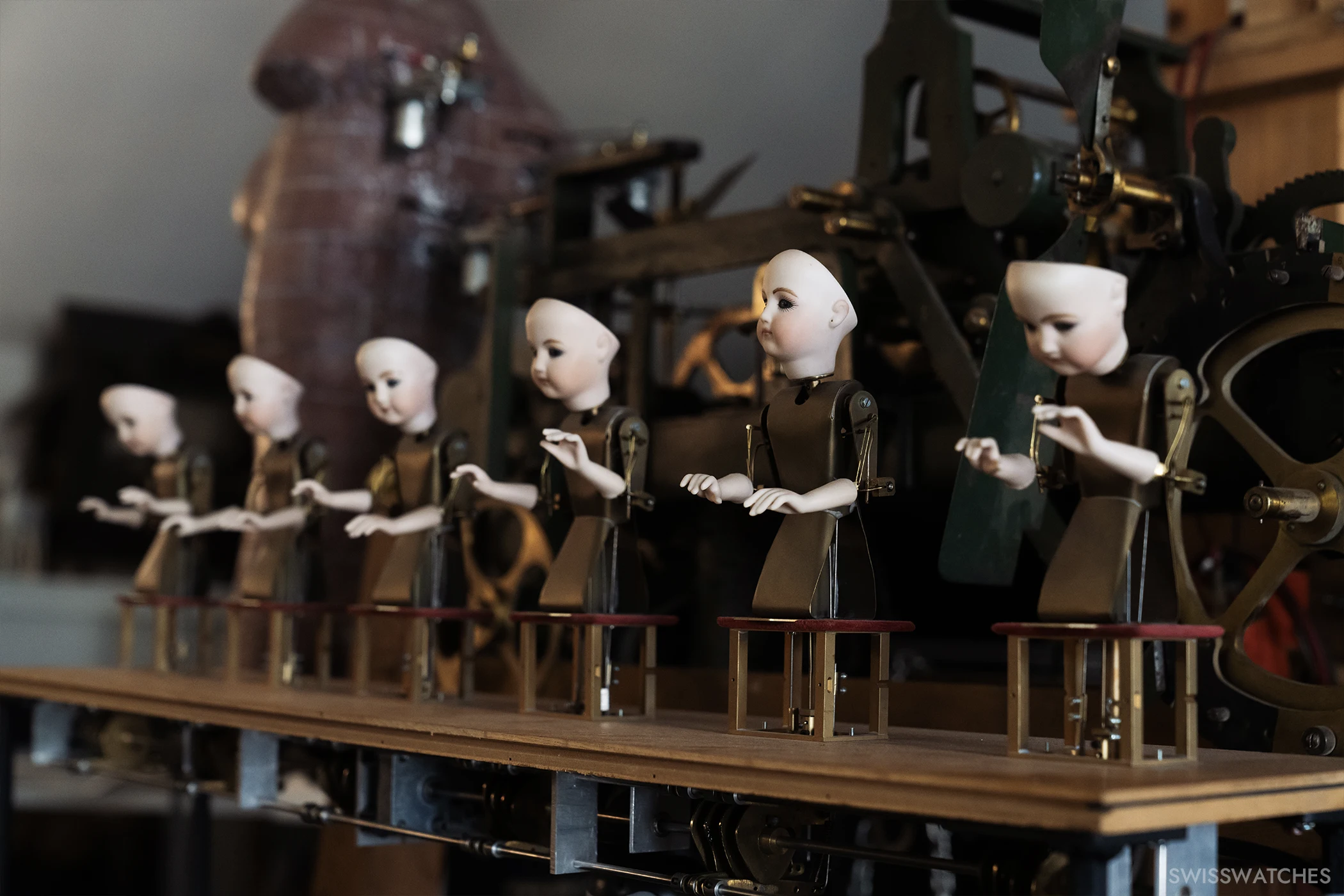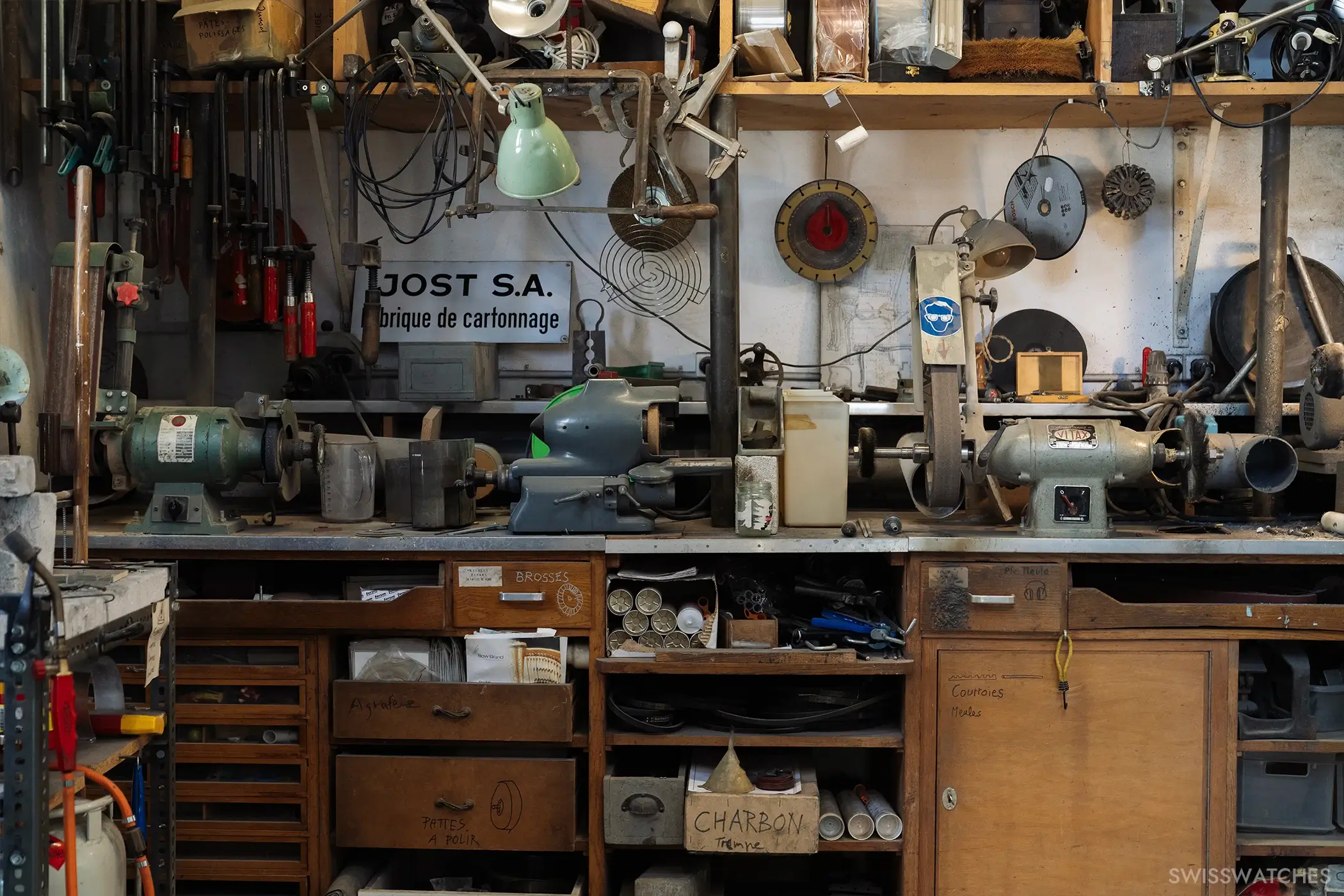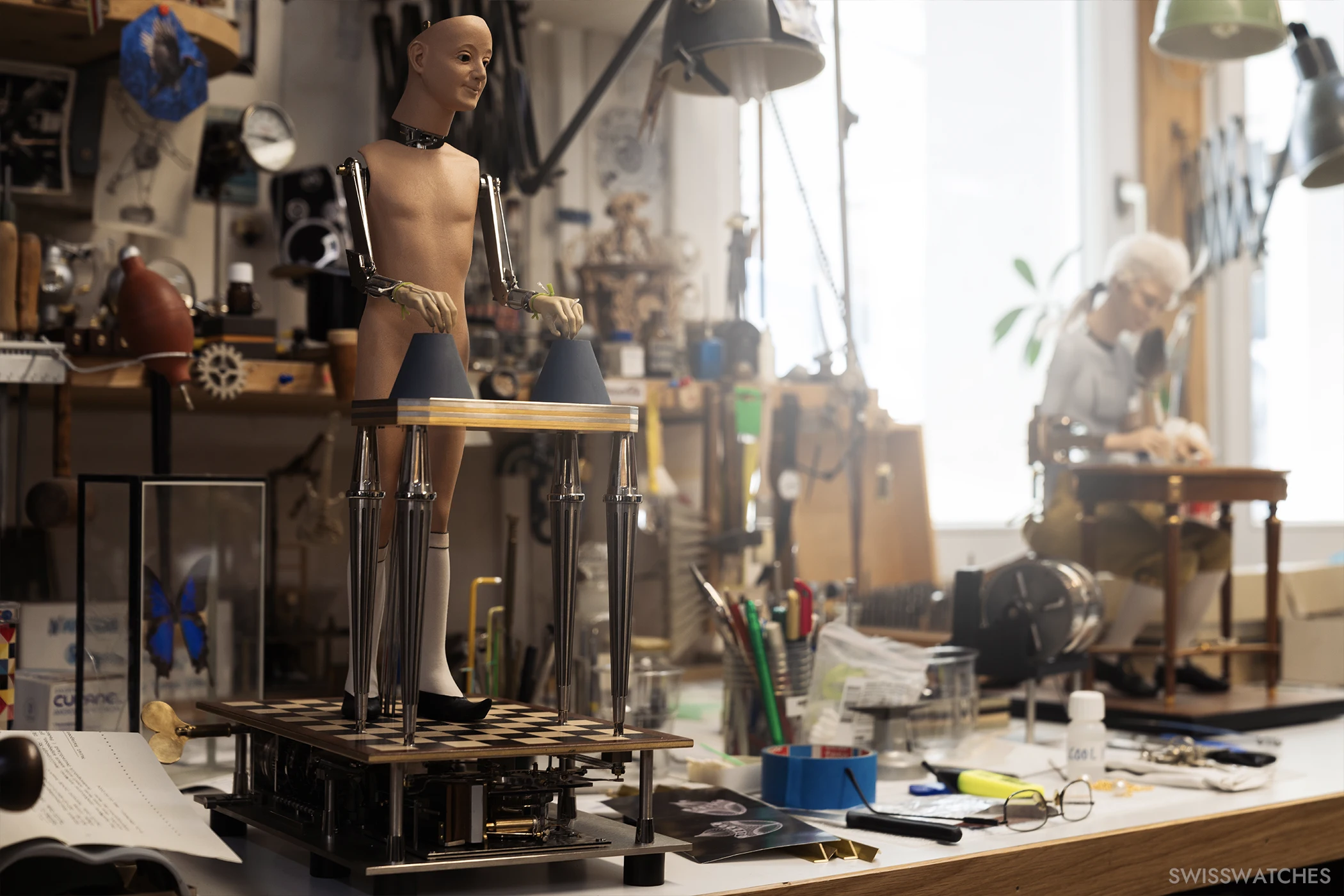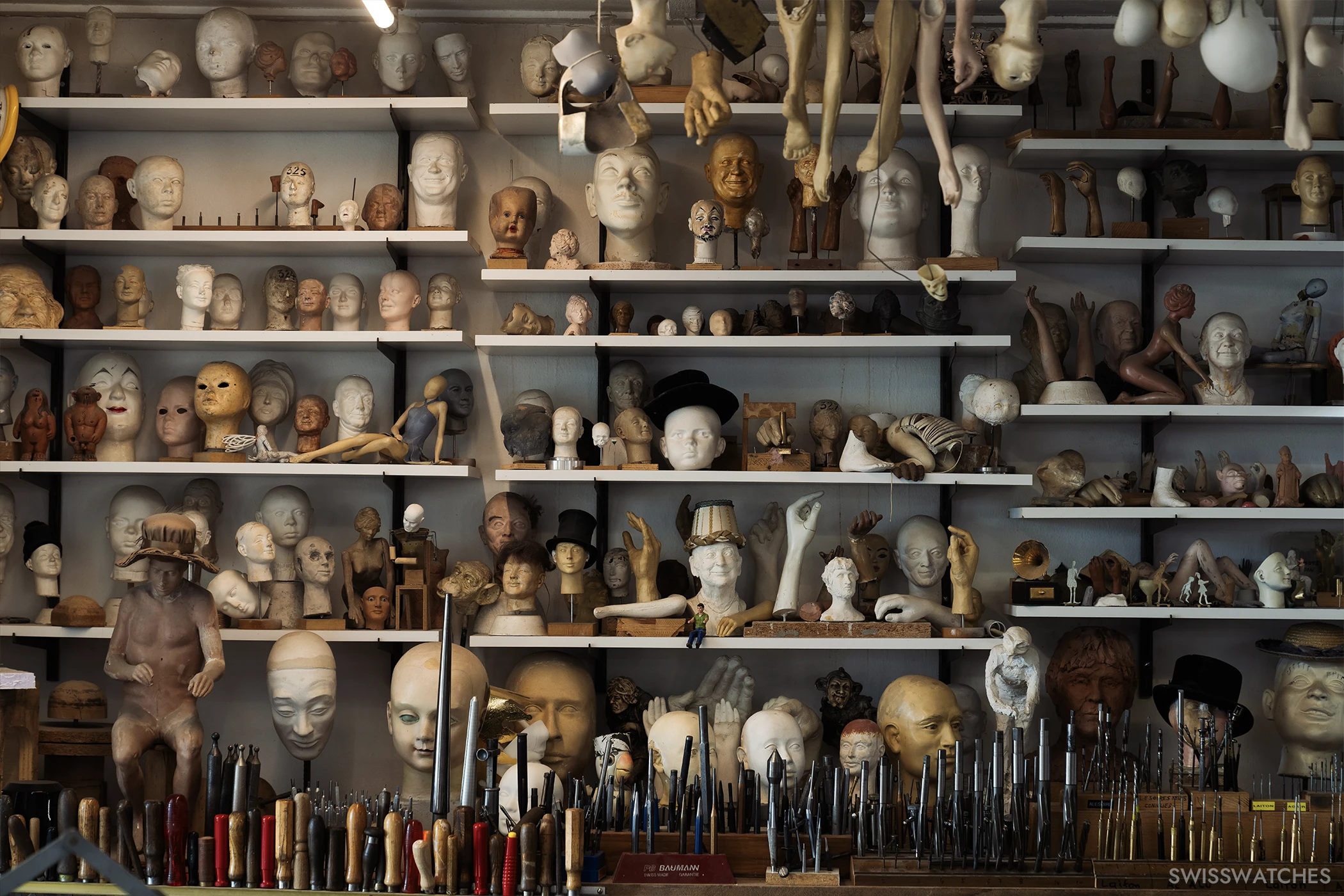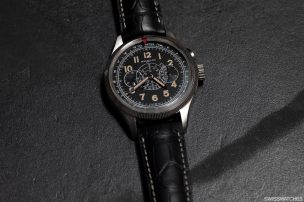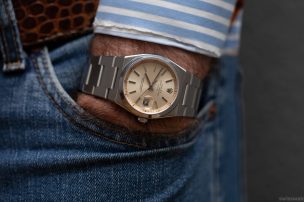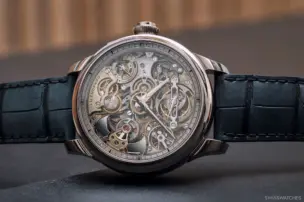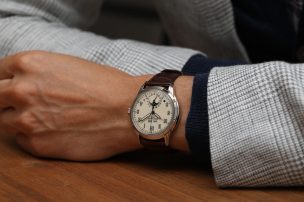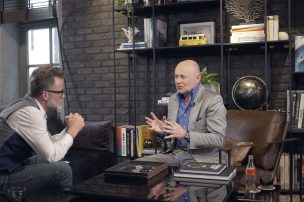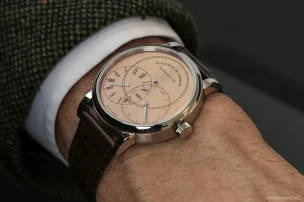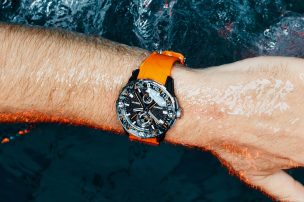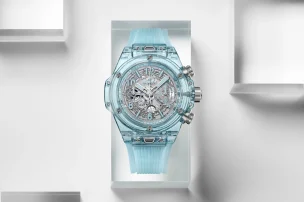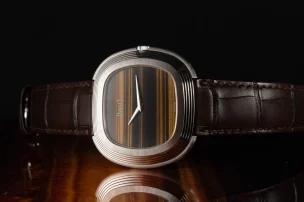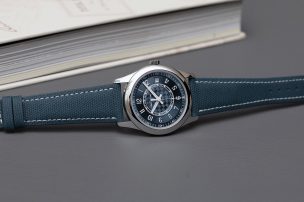

W&W 2025: Van Cleef & Arpels – Director of Research Rainer Bernard and Head of Timepieces Pascal Narbeburu Talk Novelties
Out of the 60 watch brands attending Watches and Wonders, from highly anticipated horological giants like Patek Philippe to independent geniuses like Christiaan van der Klaauw, Van Cleef & Arpels is a booth that journalists and retailers alike particularly look forward to visiting. It’s not just because of the brand’s inevitably enchanting stand design; watchmaker and jeweller Van Cleef & Arpels plays host to some of the most ethereal, attractive, and simultaneously complex creations on display at the international watch fair. From chiming automaton planetariums to enamel dial wristwatches with mechanically embracing couples, 2025 is no different. We headed to Geneva ahead of the fair to take a closer look, where the long-standing Director of Research, Rainer Bernard, as well as Head of Timepieces, Pascal Narbeburu, were ready to give us insights into these very special pieces.
Van Cleef Novelties Watches & Wonders 2025: What’s important?
This year, the ever-romantic Van Cleef & Arpels is honing in on its Parisian heritage, not least within its Poetic Complications. This takes form in the colourful Pont des Amoureux (Bridge of Love) and Lady Arpels Bal des Amoureux Automate watch, combining Métiers d’Art with mechanical expertise. As these novelties make clear, great detail is also paid to the art of gem-setting. As always, the brand also embraces its expertise in horological complications, while simultaneously teaming up with other external experts to enhance their know-how in everything from bells for chiming mechanisms to automatons – something you can read about in more detail not only here, but also in our article with Van Cleef & Arpels’ Timepieces Director, Pascal Narbeburu.
Our brand is defined by love stories, enchanting nature, fairies, and ballerinas. Even if a watch’s theme is inspired by nature, we always engrave a lucky fairy onto the movement as a signature touch. Poetic astronomy also plays a significant role, as seen in our planetarium collections. Fashion and haute couture influence our designs as well, inspiring timepieces that reflect elegance without a specific narrative.
Rainer Bernard, Director of Research
Poetic Complications collection
‘Poetic Complications complications are essential to our storytelling,’ says Timepieces Director Pascal Narbeburu. ‘Without a narrative, there is no reason to develop a timepiece. Every watch starts with a story, which is interpreted by the design studio. When we receive their sketches, we have no idea how we will create the watch – we don’t know the mechanism or the technical challenges yet. Year after year, we realise just how complex these poetic complications are, which is why they deserve the name.’
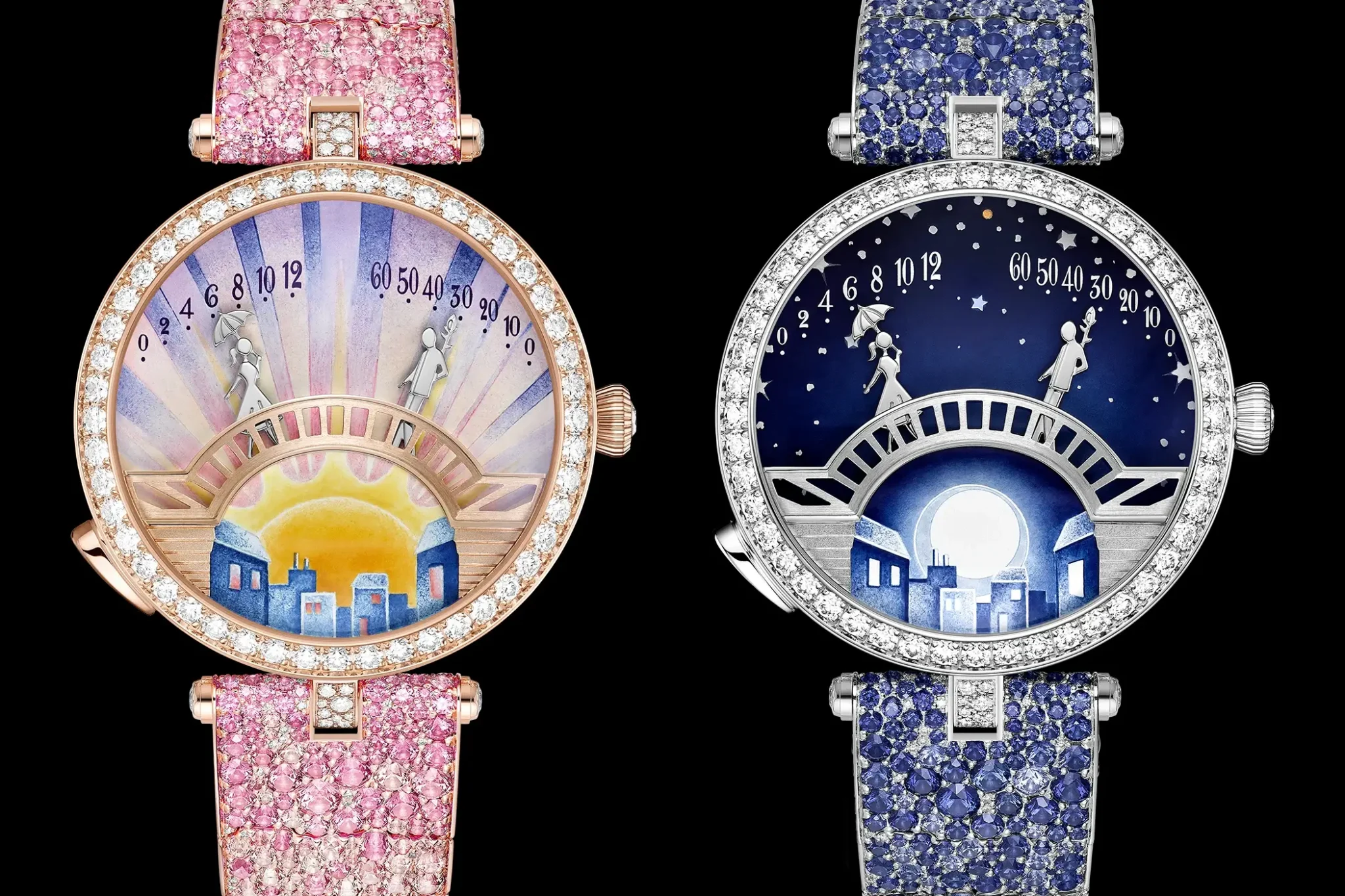
His technical counterpart, Rainer Bernard, is keen to supplement this: ‘Our development process starts with a story – not technology. As an engineer, I could create a cutting-edge mechanism and pass it to marketing, but that’s not how we work. Instead, we begin with a poetic idea – perhaps two birds meeting or dancers performing – then determine how to bring it to life. It’s a back-and-forth process between research, development, and artistry, refining our ideas over four years before production. When we finally create the watch, we find it remains remarkably close to our initial vision.’
Pont des Amoureux
As already touched upon, this collection is really all about combining various elements: mechanical expertise, precious materials, and Métiers d’Art. We can start by taking a closer look at the Pont des Amoureux watch, first introduced back in 2010, when it made history as the first piece from the collection to win a prize at the revered Grand Prix d’Horlogerie de Geneve (Narbeburu proudly likens it to winning an Oscar). This watch model always tells the same story: two lovers meet on a bridge somewhere in Paris. This year, their meeting is spread over four watches, and thus four times of day: ‘Aube’, Soiree’, ‘Matinee’ and ‘Clair de Lune’.
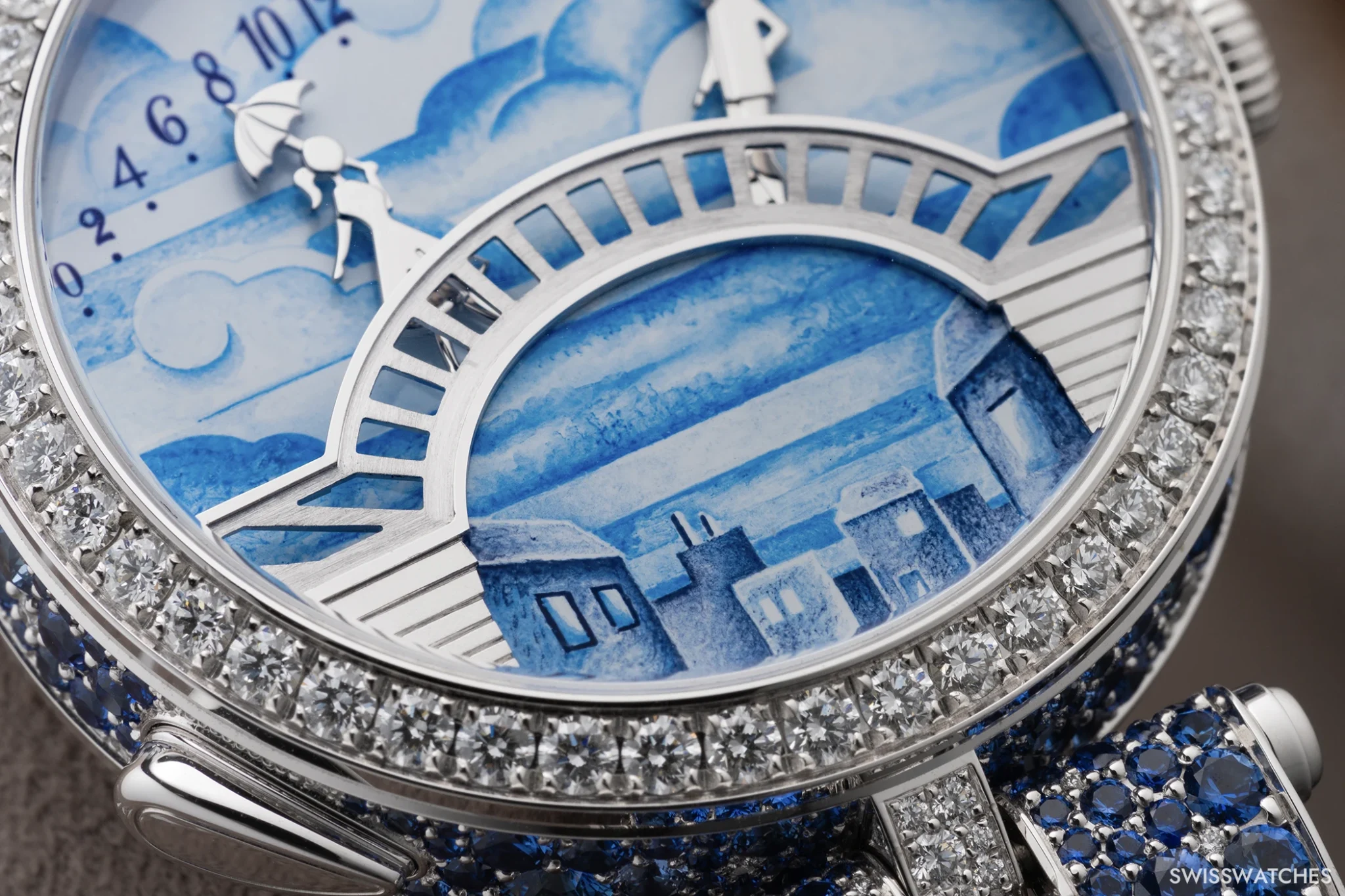
Working with enamel: No small feat
Romantic as it may be, the watch is also highly technical, with the arched hours and minutes creeping towards each other across the upper half of the grisaille enamel dial. Enamel work dates back 7,000 years to Mesopotamia, where it was used for decoration and protection. As Narbeberu explains, enamel is a luxurious and technical form of glass, infused with oxides and particles to create different levels of transparency and opacity. The production process involves layering enamel grains onto the dial, firing them in a kiln, and refining the details. Depending on the desired effect, a dial can require anywhere from four to 210 layers.
What’s more, Narbeberu informs us, traditional techniques are not enough for Van Cleef, which prefers to push boundaries to discover new materials and processes that can enhance its storytelling. One of the maison’s signature techniques is ‘grisaille’ enamel, which allows the maison to create gradients of colour using minute particles that settle on the surface. Initially, grisaille was limited to black and white, but Van Cleef has since developed a range of colours exclusive to the maison. Each of the Pont des Armoureux watch dials is the work of an in-house craftsman, each of whom meticulously shades in each mini landscape, applied like watercolours – and we are lucky enough to see this delicate work take place first-hand.
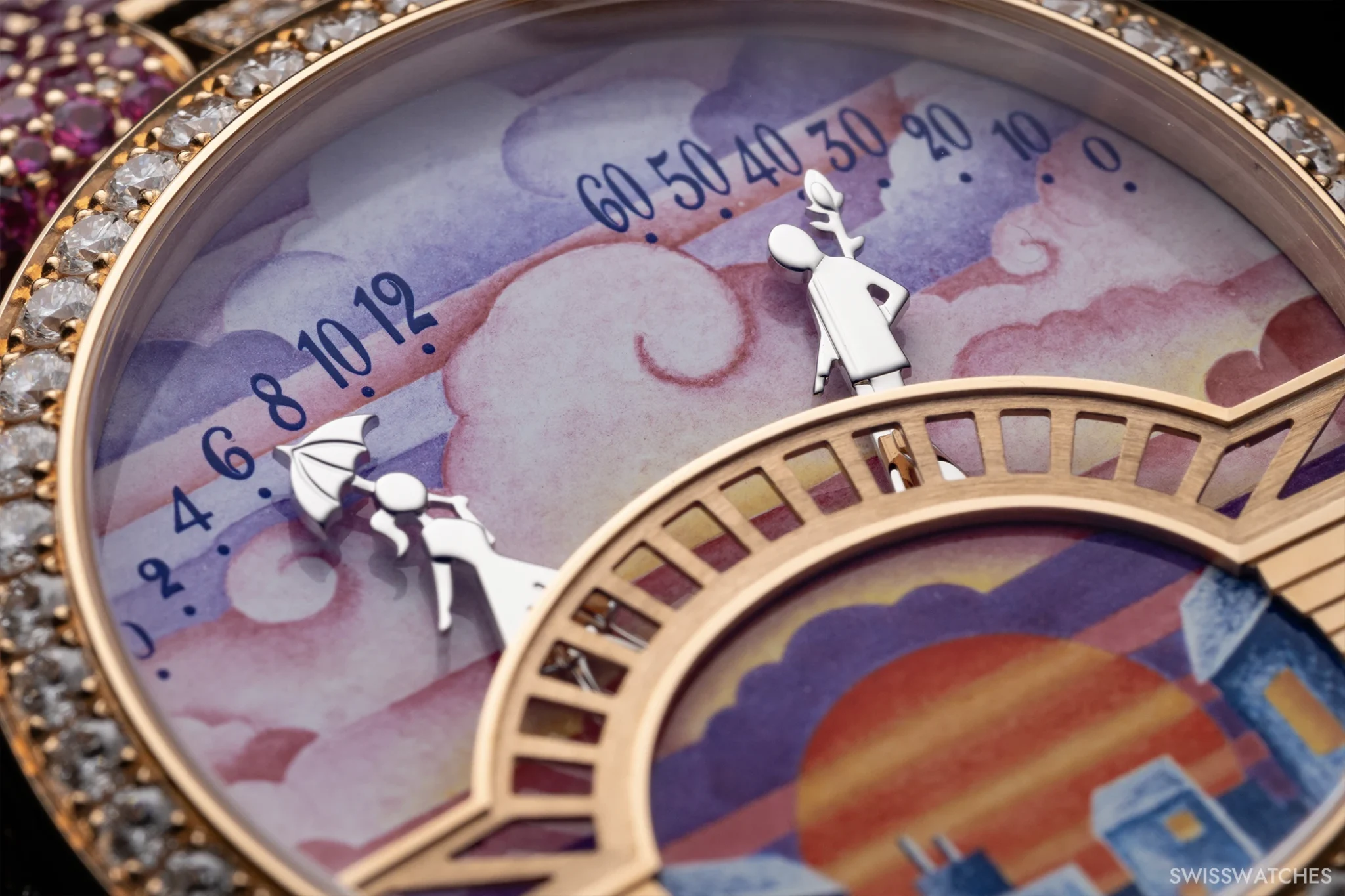
For the pink grisaille dials seen here, Van Cleef developed no fewer than 60 new colours, with 15 being selected for the final products. ‘Developing all 60 was necessary to achieve the perfect shades’, explains Narbeberu. ‘It wasn’t about settling for “close enough.” We wanted the ideal rose shade – not a bright, flashy pink, but a subtle, elegant hue.’ Creating this specific pink hue took two years. Furthermore, an additional challenge arose when the maison attempted to apply enamel on white gold. ‘The results were terrible – the pink turned too dark’, Narbeberu elaborates. ‘We spent months experimenting with different metal alloys, but nothing worked. Eventually, we tried silver alloys, testing various options until we found the one that worked. Several months later, we thought we had it – but when the first dial came out of the oven, it warped. Silver reacts differently than gold, so we had to make it thicker. By then, the watch case and movement were already designed. This gives an insight into how we spend our time – perfecting every detail and investing time into craftsmanship.’
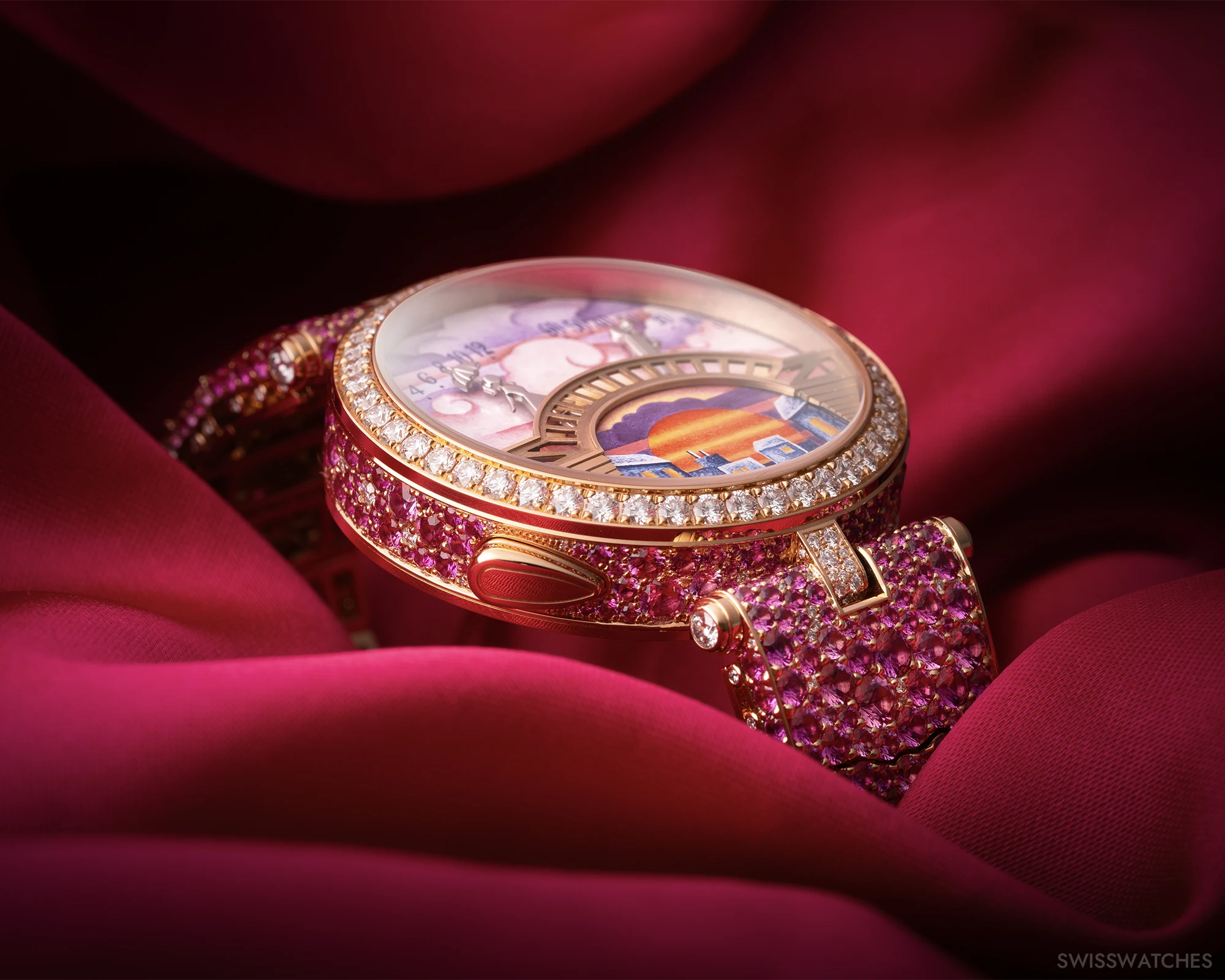
For Bernard, situations such as this is a testament as to why Van Cleef prefers to keep all its skills in-house. ‘There are inevitably so many iterations and so many refinements. If we tried to do it externally, the process would take even longer. A few years ago, we outsourced a project, but in the end, we had to take it back and finish it ourselves. Without complete mastery in-house, achieving our level of quality is impossible.’
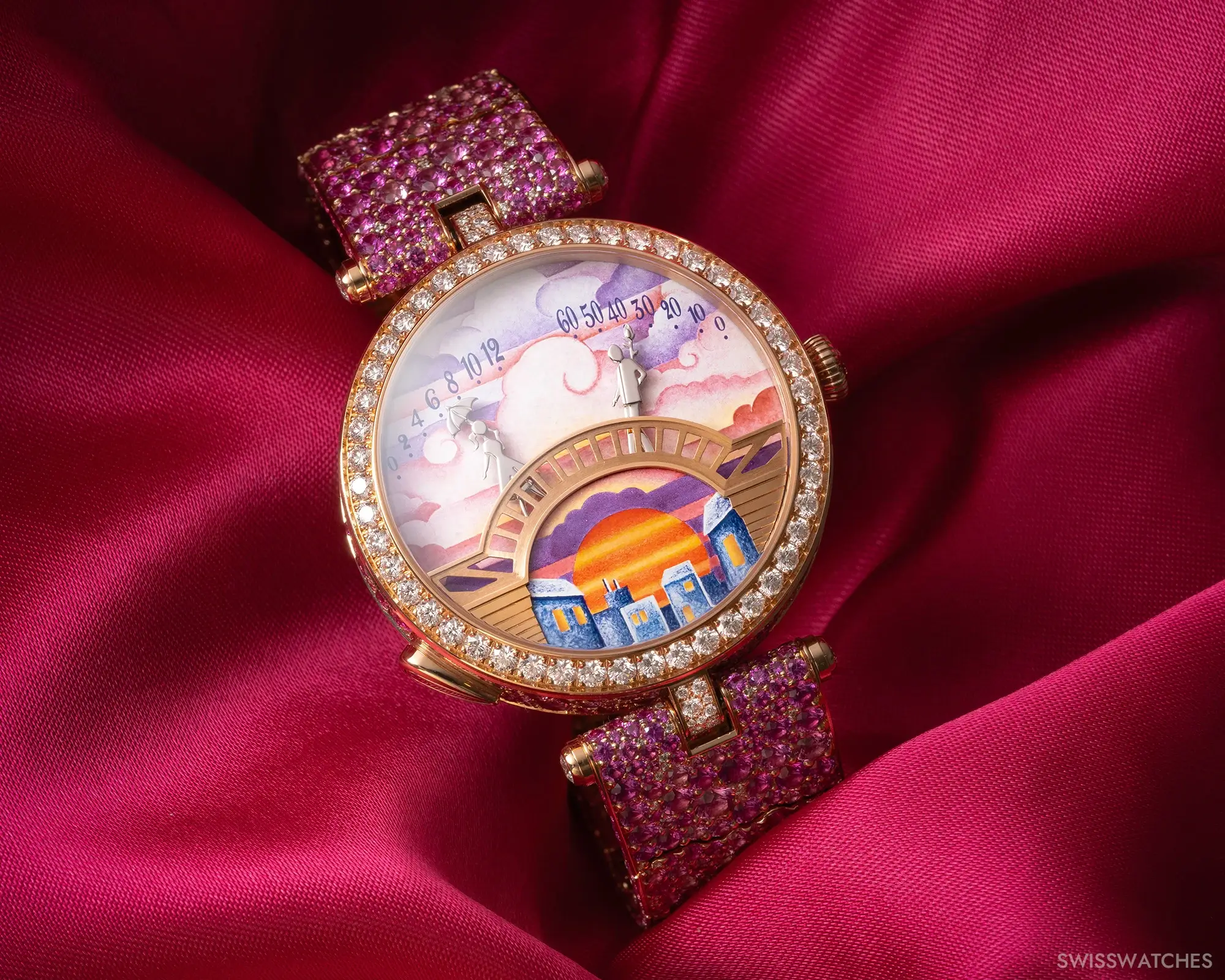
Double retrograde and on-demand animation mechanism
It’s evident that creating enamel pieces is no easy feat, and combining this craft with complex mechanics proves yet more of a challenge, as Narbeberu articulates. ‘Bringing together engineers and artisans is not easy. Each has different constraints, requiring many iterations to achieve harmony. In our workshop of 20 people, we combine expertise from more than ten different métiers, mastering age-old techniques while pioneering new ones.’
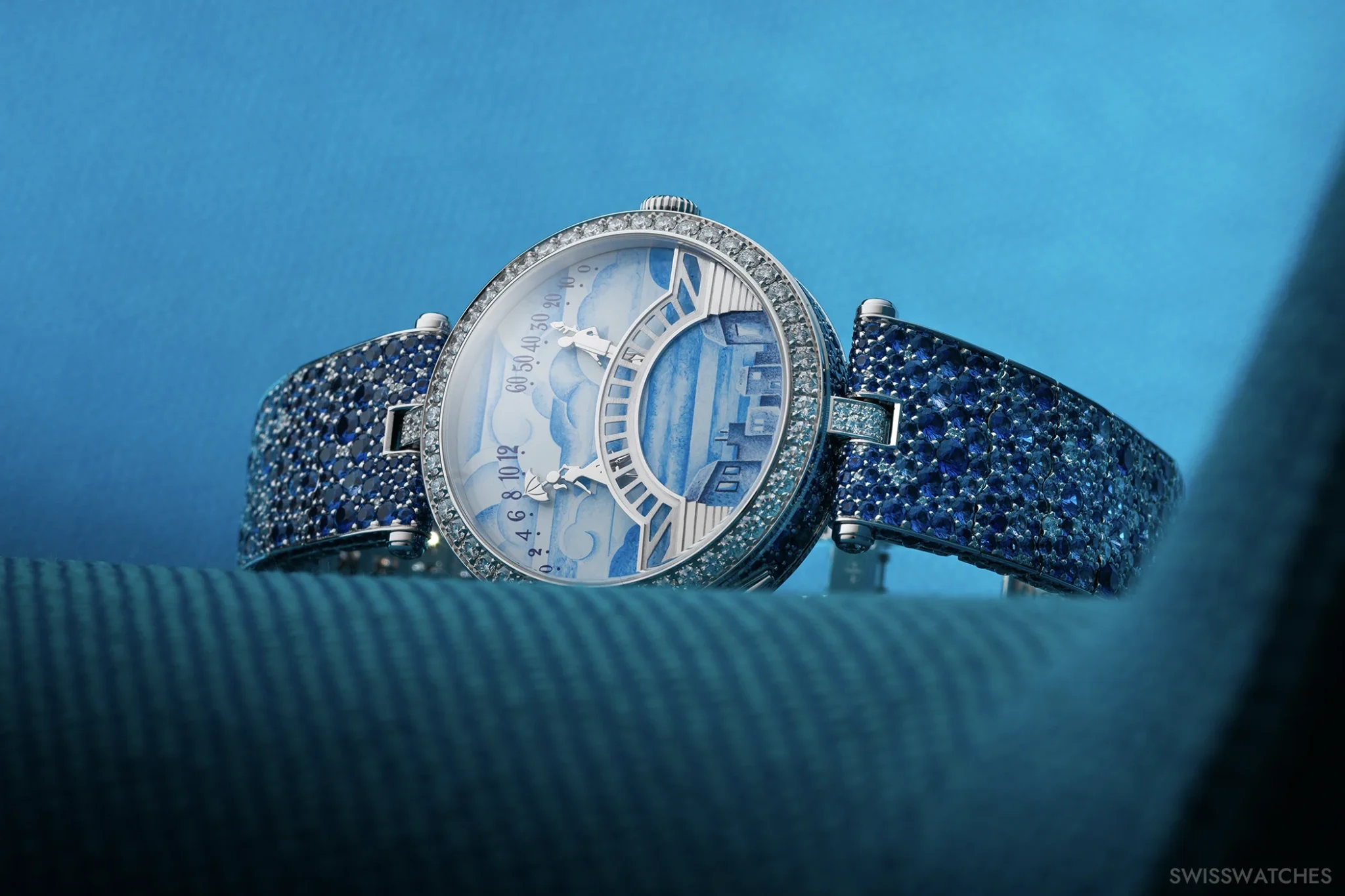
This brings us to this watch’s technical feats: the watch houses a self-winding movement with an animation mechanism, meaning the figurines on the dial move towards each other and embrace at noon and minute, or alternatively on command via a pusher at 8 o’clock. The wearer may admire the watch movement as well as further enamel decoration via the sapphire crystal caseback, including the maison’s signature fairy.
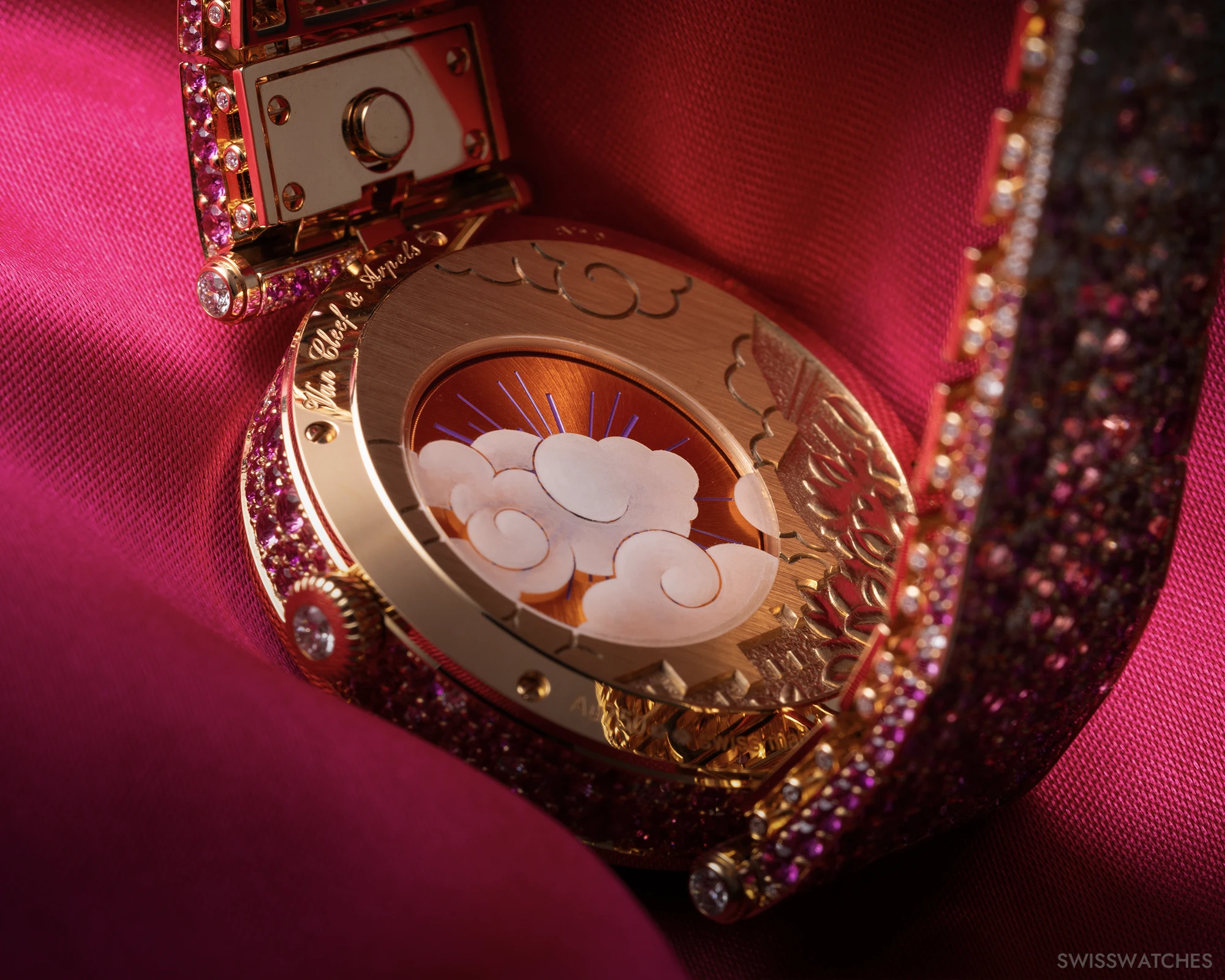
What’s more, the watch reveals intricate workings via the caseback, which more often than not remain concealed. ‘We removed the casing to reveal one element I particularly like – the speed regulator,’ explains Bernard. ‘It’s a centrifugal regulator, typically used in minute repeaters, but we use it differently: to control the speed of winding within the watch. We don’t want a storm inside the watch, so we regulate the movement. We take traditional watchmaking elements and reimagine them in innovative ways.’
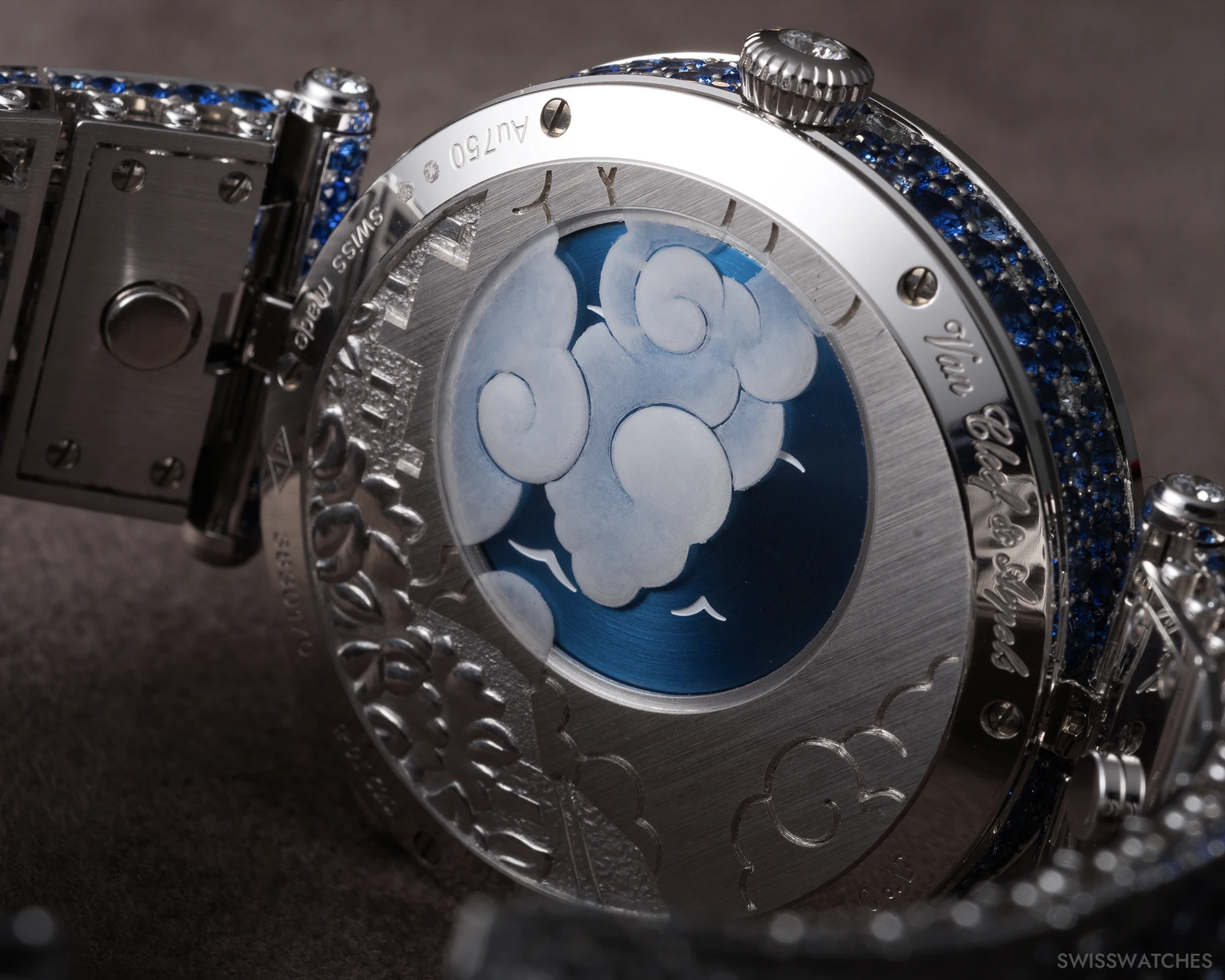
Gem-setting at the forefront
The most eye-catching part of these watches is arguably not, however the dials: the timepieces play host to glittering full-set bracelets which, despite their many gems and consequent weight, sit beautifully comfortably and flexibly on the wrist. This is owed to a special intricate meshing system, which allows the bands to adapt to the curve of the wearer’s wrist. The rose-gold models are complemented by an elegant, feminine combination of pink sapphires and diamonds. By contrast, the white-gold editions combine sapphires and diamonds. While the dial is a work of art, the movement a feat of engineering, and the watch’s story is a romance for the books, it’s really the incredibly luxurious bracelet that brings these already impressive pieces together.
Our watches are not just timepieces—they are expressions of art, poetry, and craftsmanship. By blending traditional savoir-faire with innovation, we create watches that tell stories, evoke emotions, and capture the essence of time itself.
Pascal Narbeberu
Lady Arpels Bal des Amoureux Automate
Another addition to the Poetic Complications collection will prove particularly interesting to not only Van Cleef fans, but horology enthusiasts in particular: the Lady Arpels Bal Amoureux Automate. As I argued back in 2022 when taking a closer look at the Lady Arpels Heueres Florales, there is more often than not a horological masterpiece lying below these watches’ attractive facades. That particular piece marked Van Cleef’s first watch without traditional hands. Rather, it featured six petals per flower, with the wearer counting blooming flowers in order to tell the time. ‘It was one of our most complex creations,’ adds Narbeburu. It’s also an all-too rare privilege, one might add, to see such complex watches designed specifically with women in mind.

Lady Arpels Bal Amoureux Automate: Romance personified
The Lady Arpels Bal Amoureux Automate brought a new chapter to Van Cleef’s love story, depicting the lovers meeting, as always, in Paris – this time in an open-air bar called guinguette. These are traditional riverside cafés along the Marne, south of Paris, where people gather to eat, drink, and dance. Van Cleef decided to recreate this lively atmosphere. The automaton is thus based on this setting; it’s not about a specific location, as one of the maison’s craftswomen explains, but about capturing a mood, or a feeling.
Another romantic design for the Poetic Complications collection
Mechanics aside for a moment, Van Cleef & Arpels opted for yet another romantic design in the collection, likewise using the traditional grisaille enamel technique – something of a signature at the maison. First developed in France back in the 1500s, the technique requires Van Cleef’s enamellers to spend around 40 hours applying two layers of white enamel powder, ‘blanc de Limoges’, onto the alluringly dark blue background, before harmonising this with the various other blue tones and contrasting their work with various warm touches of yellow depicting beams of light. Additionally, Van Cleef opted to use contrasts between light and shadow, much like the Old Masters did in painting. ‘Colour is key,’ one of the craftswoman tells me. As well as taking a week to complete, each dial required about a dozen kiln firings, not to mention the utmost dexterity to create a three-dimensional effect on individual elements such as the clouds.
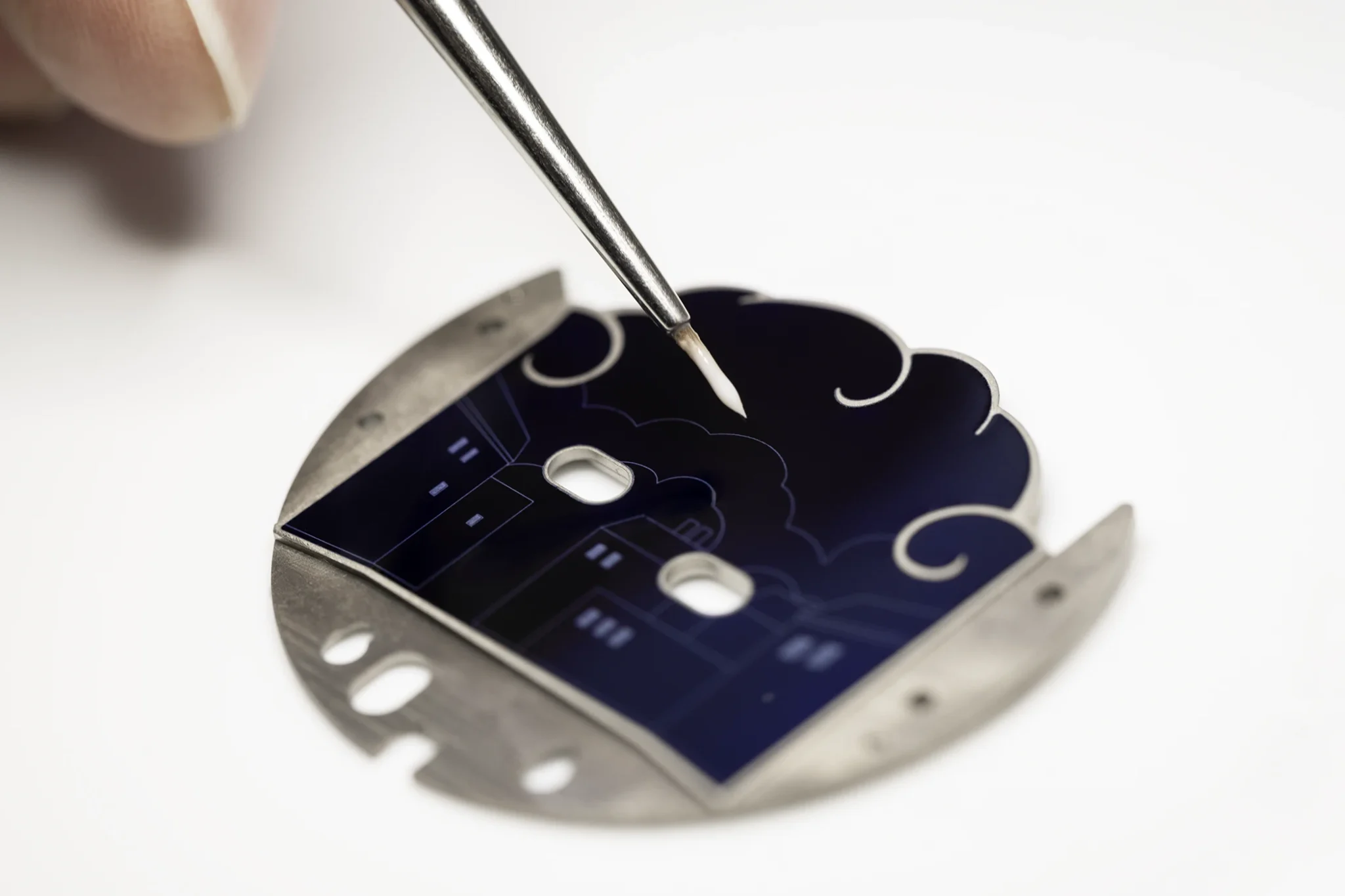

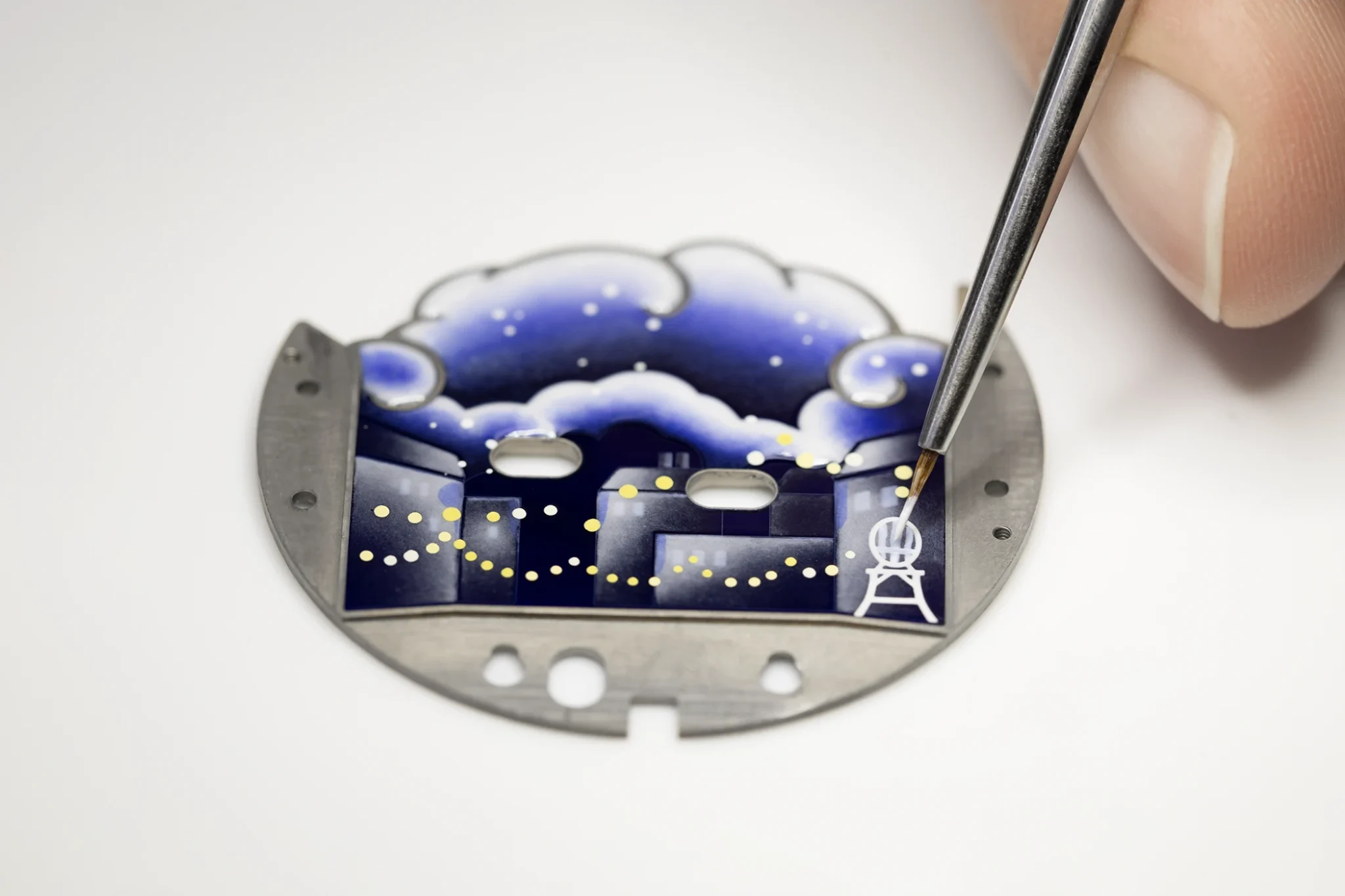
Double retrograde, 100 percent in-house automata, and an on-demand animation mechanism
Yet more impressively, the new Lady Arpels Bal Amoureux Automate marks the introduction of a new automaton movement from Van Cleef. ‘We now do all the assembly, prototyping, testing, and qualification in-house,’ explains Narbeburu. This new movement took no fewer than four years to research and develop, featuring two characters who lean in towards each other while linking arms via three articulations. The main talking point of this new mechanism design is its fluidity, which adds a degree of realism to the watch.
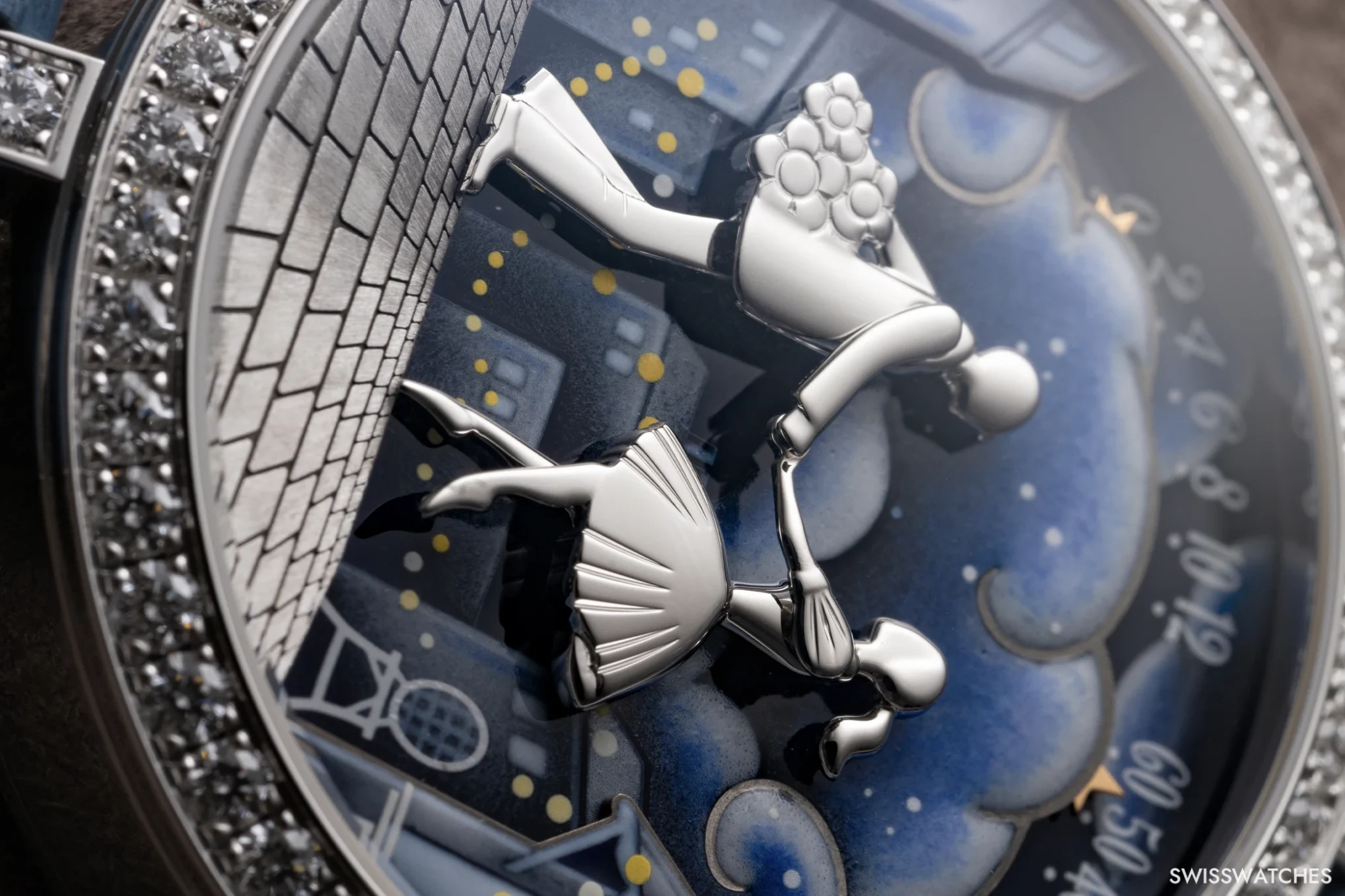
For the Lady Arpels Bal des Amoureux Automate watch, we wanted to give our lovers the most natural gestures possible. This meant articulating them and combining two simultaneous movements – their approach as well as their inclination toward one another – while giving them a degree of freedom to ensure the fluidity of the animation. The difficulty lay in achieving several natural gestures without altering the precision of the mechanism.
Rainer Bernard, Director of Research
Rainer Bernard, Director of Research
Initially, the lovers simply moved towards each other, held hands, and kissed – but Van Cleef then realised it had never done articulated hands that actually connect. That was a challenge worth pursuing. After much testing and engineering, the maison developed a system with three articulations: at the waist, arm, and hand. During testing, however, Van Cleef’s engineers discovered something unexpected. The lovers were supposed to kiss precisely at midnight and midday, but after a few hours, they were creeping towards each other prematurely. They were so attracted to each other, one might say, that they subtly moved closer over time. Van Cleef’s engineers had to modify the movement to prevent this, ensuring they only kissed at the intended moments or on command.

This challenge aside, the Lady Arpels Bal Amoureux Automate’s movement itself was a major technical challenge. It had to synchronise the retrograde stars that indicate the time with the movement of the lovers. Despite its complexity, Van Cleef managed to achieve this with only four additional components – something they’re very proud of.
Overall, the watch is a strong signal that Van Cleef intends to continue to develop ever-more complex pieces, with this particular calibre with in-house automaton consisting of no fewer than 533 components. ‘You might think, “Oh my God, why so many?”’, adds Narbeberu. ‘But I can assure you, we need every single one. Our design philosophy is to make things as simple as possible – overcomplicating is never good.’ He takes a moment to mull over his point. ‘You probably do the same when writing your articles; if it’s too complex, people won’t understand. The same principle applies here. Even with 533 components, each one has a purpose. That’s our signature style.’

Another fascinating aspect of this piece is the way Van Cleef & Arpels combines high-level technical expertise with Métiers d’Art. The interface between these two is incredibly difficult to master. After all, the calibre integrates handmade components and others that require precision down to the micron. ‘Marrying the two is a real challenge’, supplies Narbeberu. ‘Notice how you don’t see any screws or fasteners? You have no idea how it’s assembled. Hiding the technique is far more difficult than showcasing it. Would you imagine having a large screw visible here? No – absolutely not. That’s also part of our DNA: ensuring the movement serves the story.’
Extraordinary objects
For all these watches’ virtues, the ‘Extraordinary objects’ segment is perhaps the most visually stimulating of all Van Cleef’s portfolio. These large automata are often unique pieces, and their display at Watches & Wonders offers the once-in-a-lifetime opportunity to see them in action.
Nassiance de l’Amour
The Nassiance de l’Amour is one such piece; and not only do we have the pleasure of seeing it at the watch fair, but also well in advance, not yet fully assembled, at the François Junod studio in Sainte-Croix, Switzerland. As Pascal Narbeburu (LINK TO ARTICLE) emphasised in his interview, Van Cleef is unique in the sense that it openly works with smaller external specialists and ateliers in order to create the perfect piece.
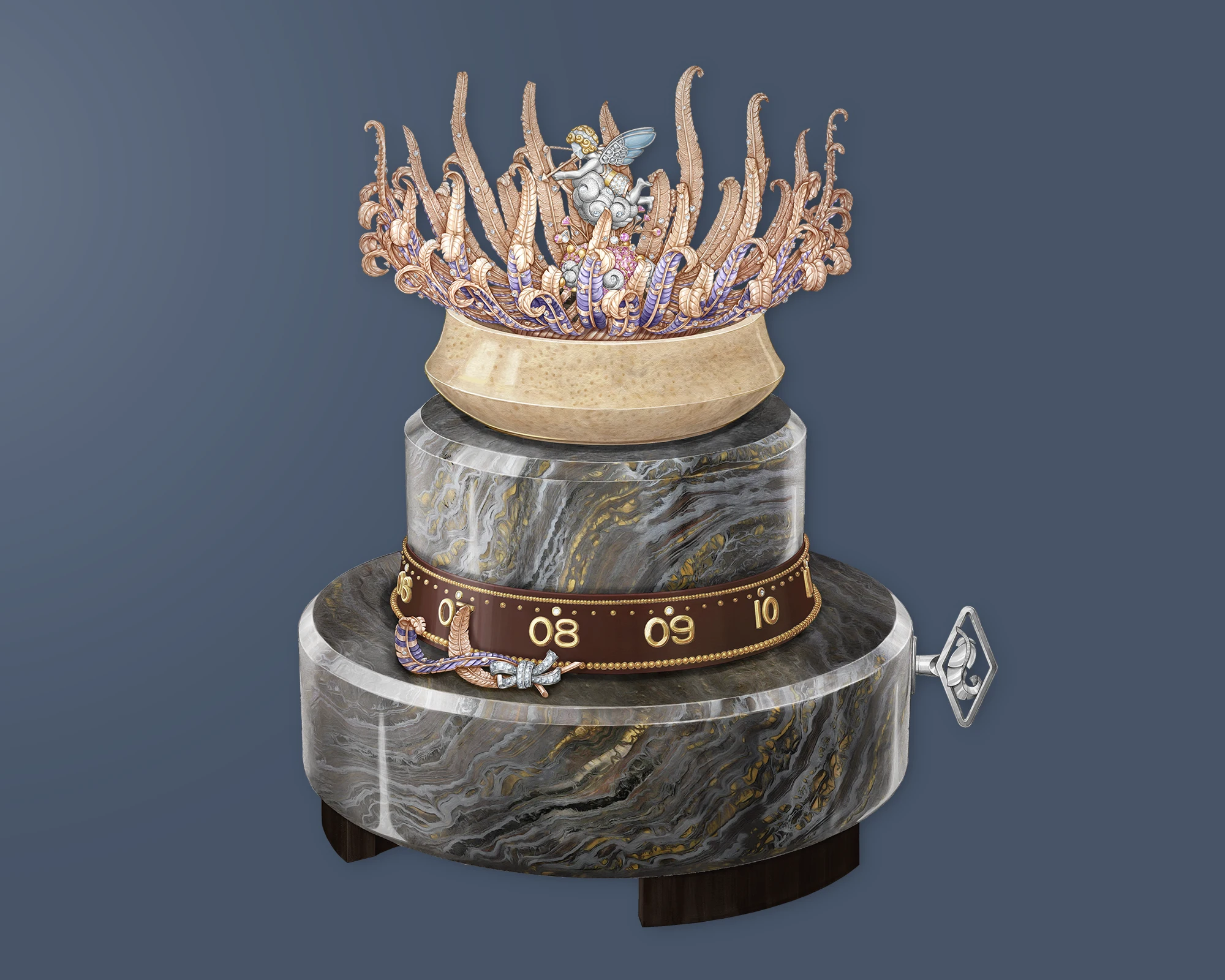
François Junod atelier
Nestled high up in Sainte-Croix, François Junod’s atelier has been bringing automata to life since 1984, blending tradition with contemporary artistry. Upon entering the atelier, one is greeted with a vast array of ambitious inventions: colossal wire rings hang from the ceiling, mannequin heads line the walls, paintings stand against industrial metal doors. One gem is an automaton playing a ‘cups’ magic trick, in which a tiny blue bird flutters beneath one cup and then promptly vanishes. ‘This is a favourite for the children’, Junod remarks.
Together with his team, a closely knit young group of engineers, he builds writing Pierrots, elegant dancers, orchestras of animals, poets, and musicians – creations that have found homes across Switzerland, Japan, Spain, France, Italy, Great Britain, the United States and beyond.
But how does his work fit to Van Cleef & Arpels? A master of the rare craft of mechanical automatons, Junod’s work is rooted in both technical precision and artistic vision, shaped by his studies in micro-mechanics and fine art. His automata, from the Angel of the CIMA Museum to The Walking Man and the Singer’s Bust at the Geneva Arena, are as much about poetry as they are about mechanics. He does not conceal the gears, springs, and cogs; instead, they become part of the aesthetic, a tribute to the ingenuity of movement. His workshop is a world of baroque intricacy, where past and present meet. But beyond the mechanics, Junod’s real pursuit is something more elusive: the fine line between machine and life itself. His automata do not simply mimic movement; they capture something profoundly human, a quiet reflection of who we are. His philosophy knits in perfectly with Van Cleef, where human stories and aesthetics play equally integral roles to mechanics.
Naissance de l’Amour: Another ornate creation from Van Cleef & Arpels
The Naissance de l’Amour (The birth of love) automaton follows on from a couple of other automatons we’ve seen from Van Cleef in recent years, including the 2022 Rêveries de Berylline, followed consecutively by the Éveil du Cyclamen and Bouton d’Or.
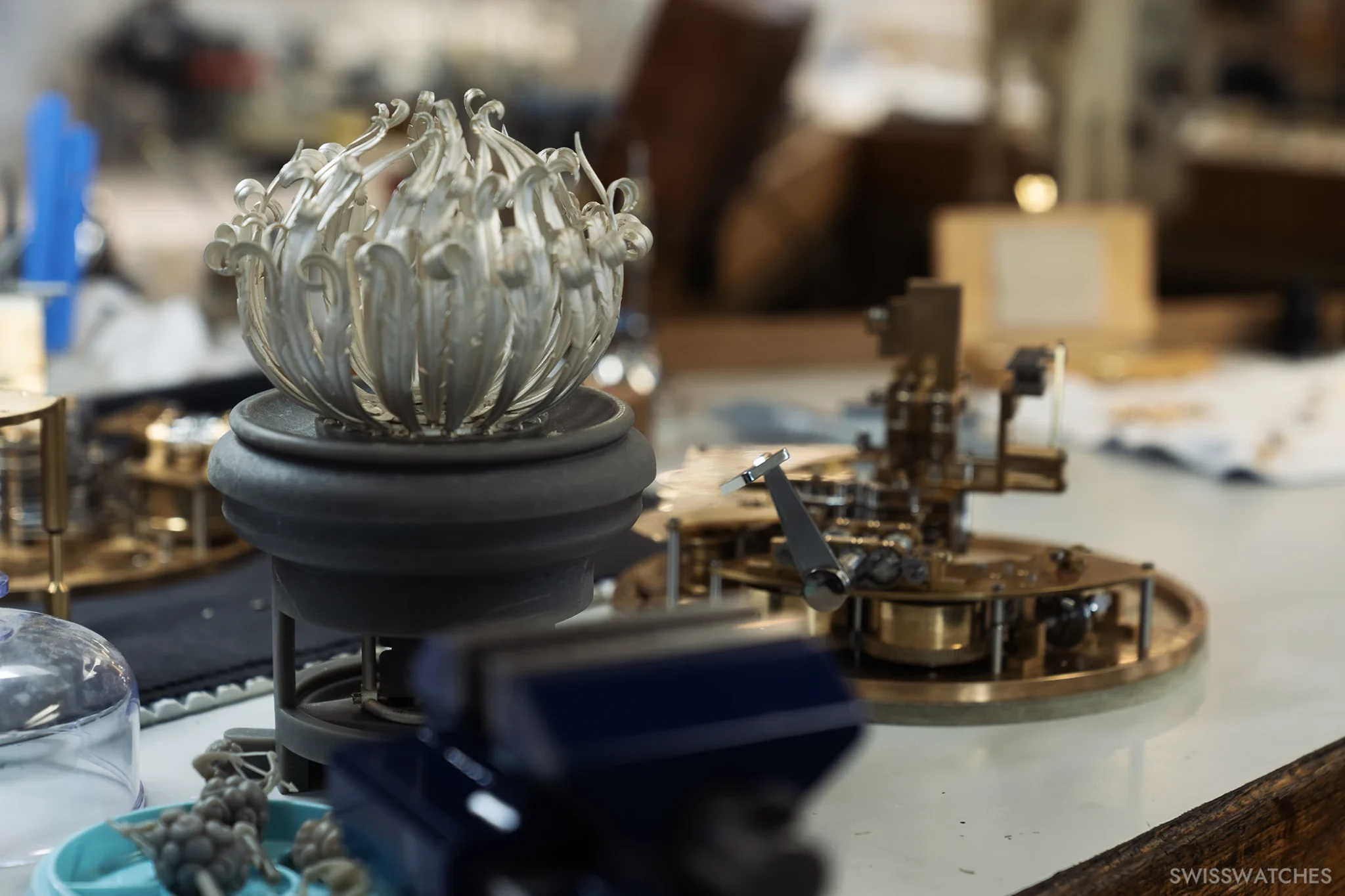
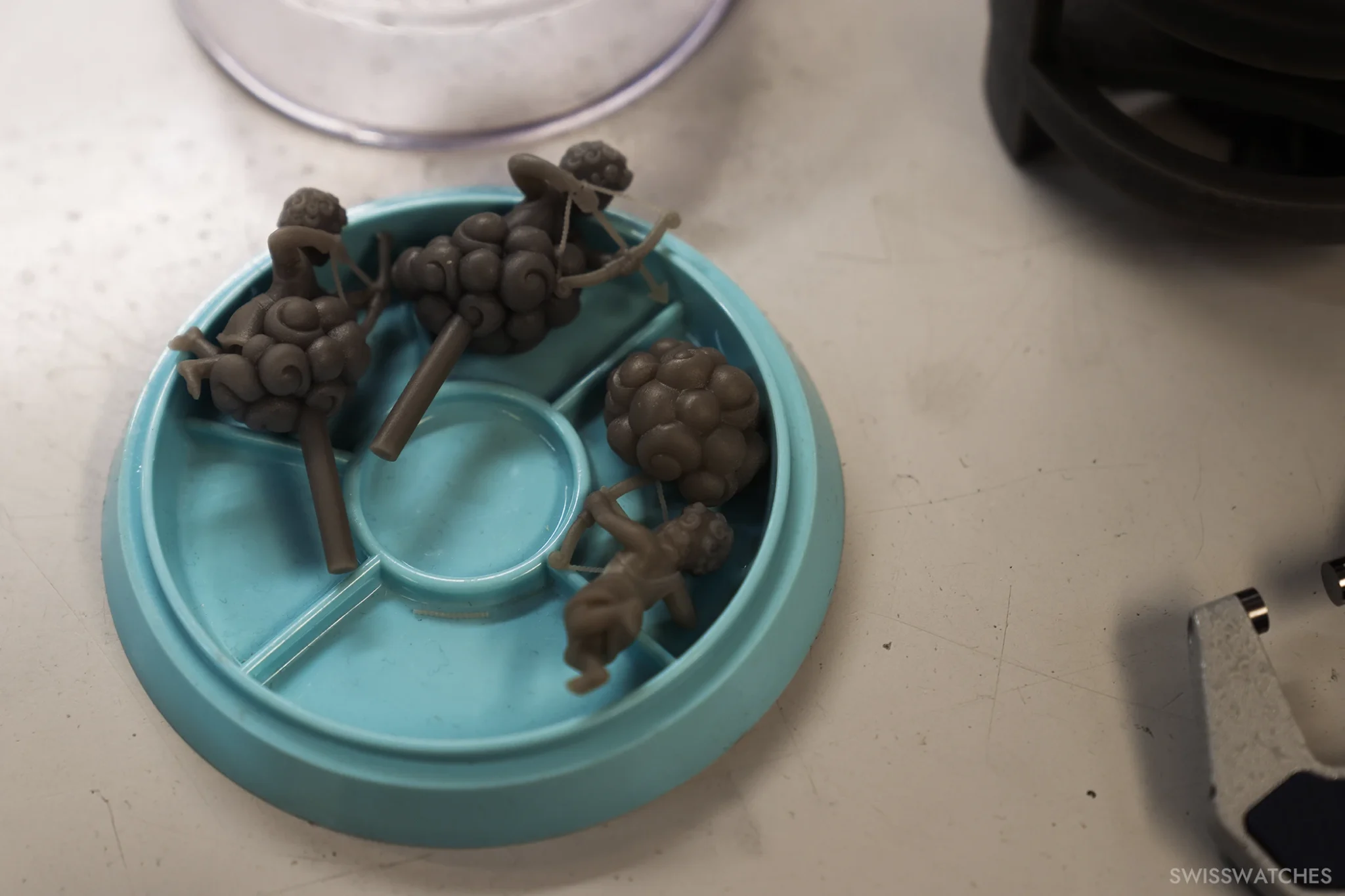
‘The birth of love’ is often associated with Cupid, or Eros in Greek mythology: the god of love and desire. In classical mythology and art, Cupid is frequently depicted as the embodiment of love’s birth; his arrows ignite passion, and his presence symbolises the very beginning of romantic attraction. In Renaissance and Baroque art, themes of Cupid’s birth or ‘the birth of love’ itself were common, often symbolising the moment love was brought forth in the world. No wonder, then, that this is an otherworldly and deeply romantic creation in many ways.
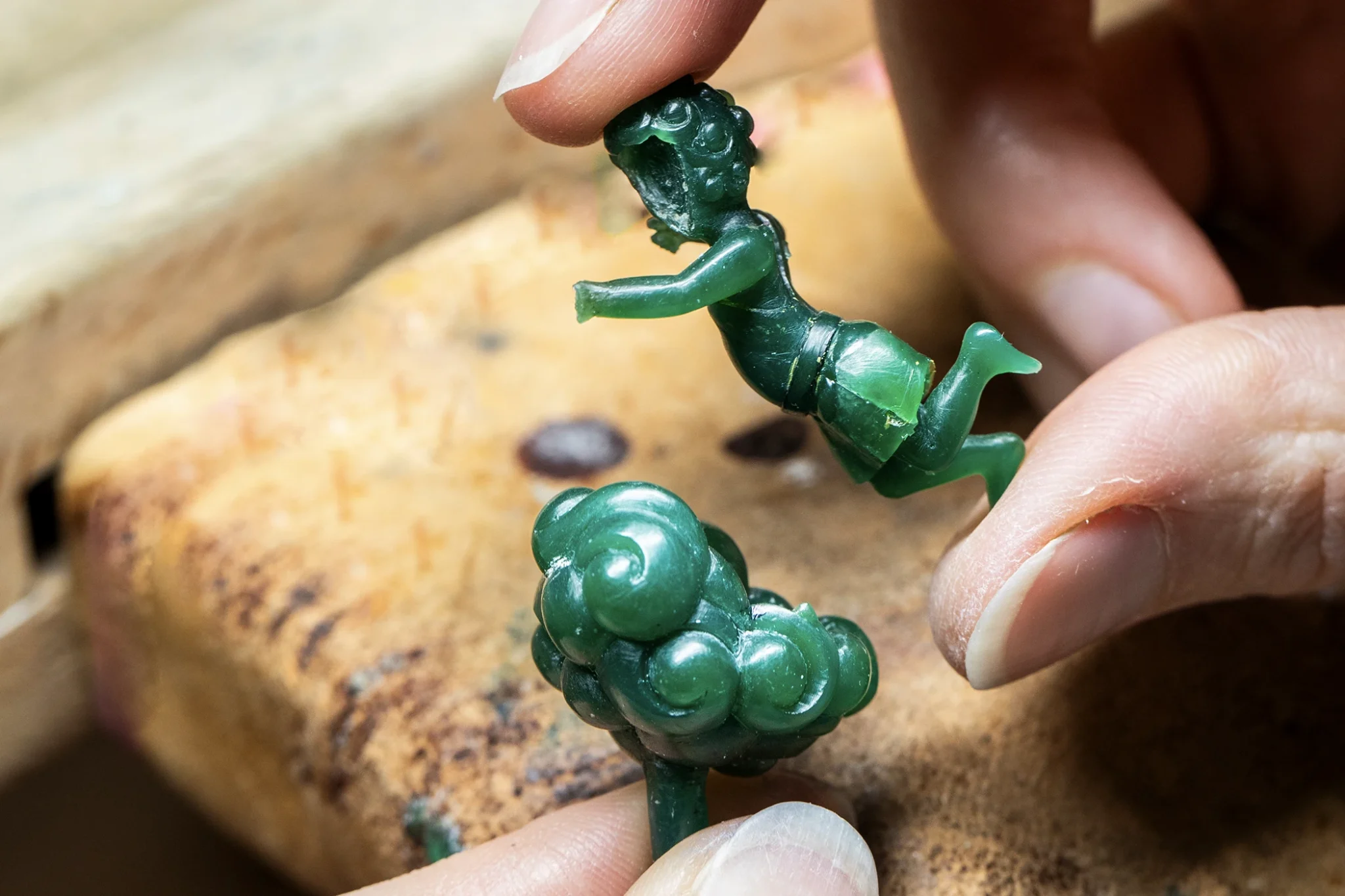
Stretching 30 centimetres high, the Naissance de l’Amour Cupid figurine emerges from a basket of feathers, sitting atop a Greek column in rose gold surrounded by clouds in white-gold, diamonds, and pink sapphires. When the automaton is activated, the figurine rotates, while its plique-à-jour enamel wings flutter. While Cupid performs, a mechanical carillon plays a delicate melody. Let’s also not forget the time, which is indicated via a graduated rotating ring using two lacquered ‘feathers’ accented with diamonds that are secured with a diamond ‘bow’.
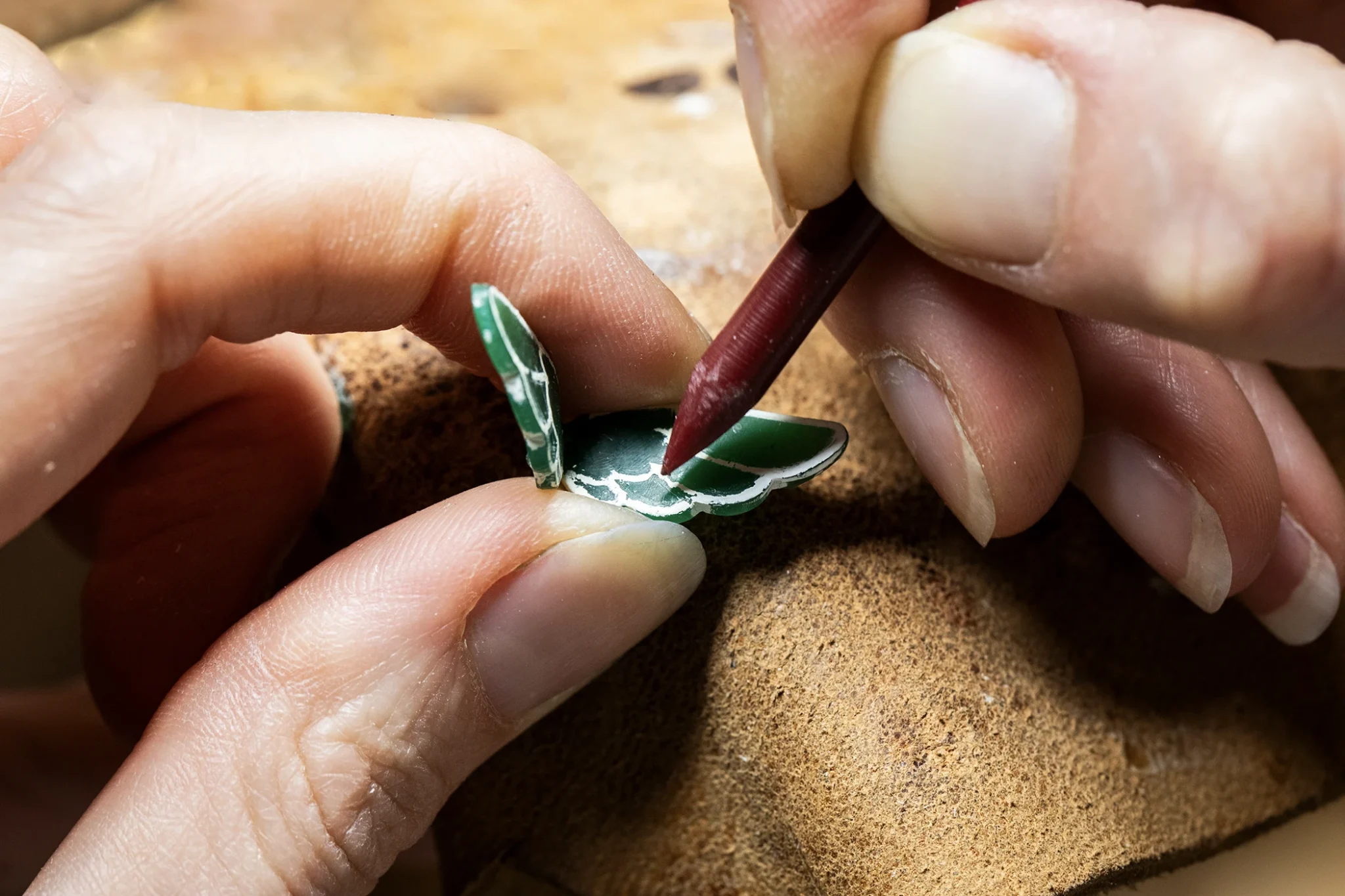
Precious stones
The automaton is placed upon an iron eye base, aka a highly variegated stone with golden streaks. Meanwhile, a bowl created from petrified palmwood gemstone makes an appearance at Van Cleef for the first time, holding the basket of feathers. Each material is meticulously chosen, cut, and polished by in-house experts.
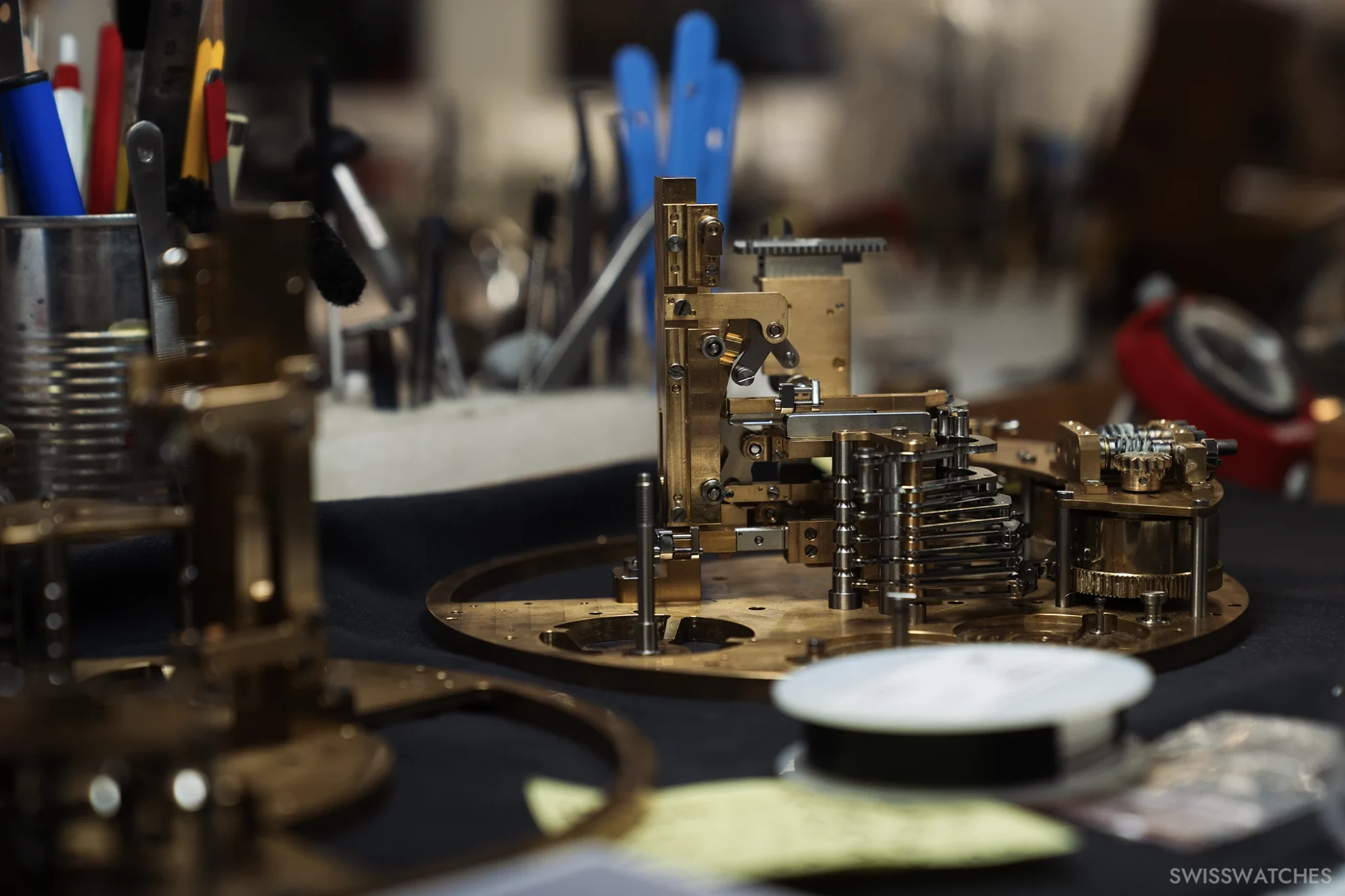
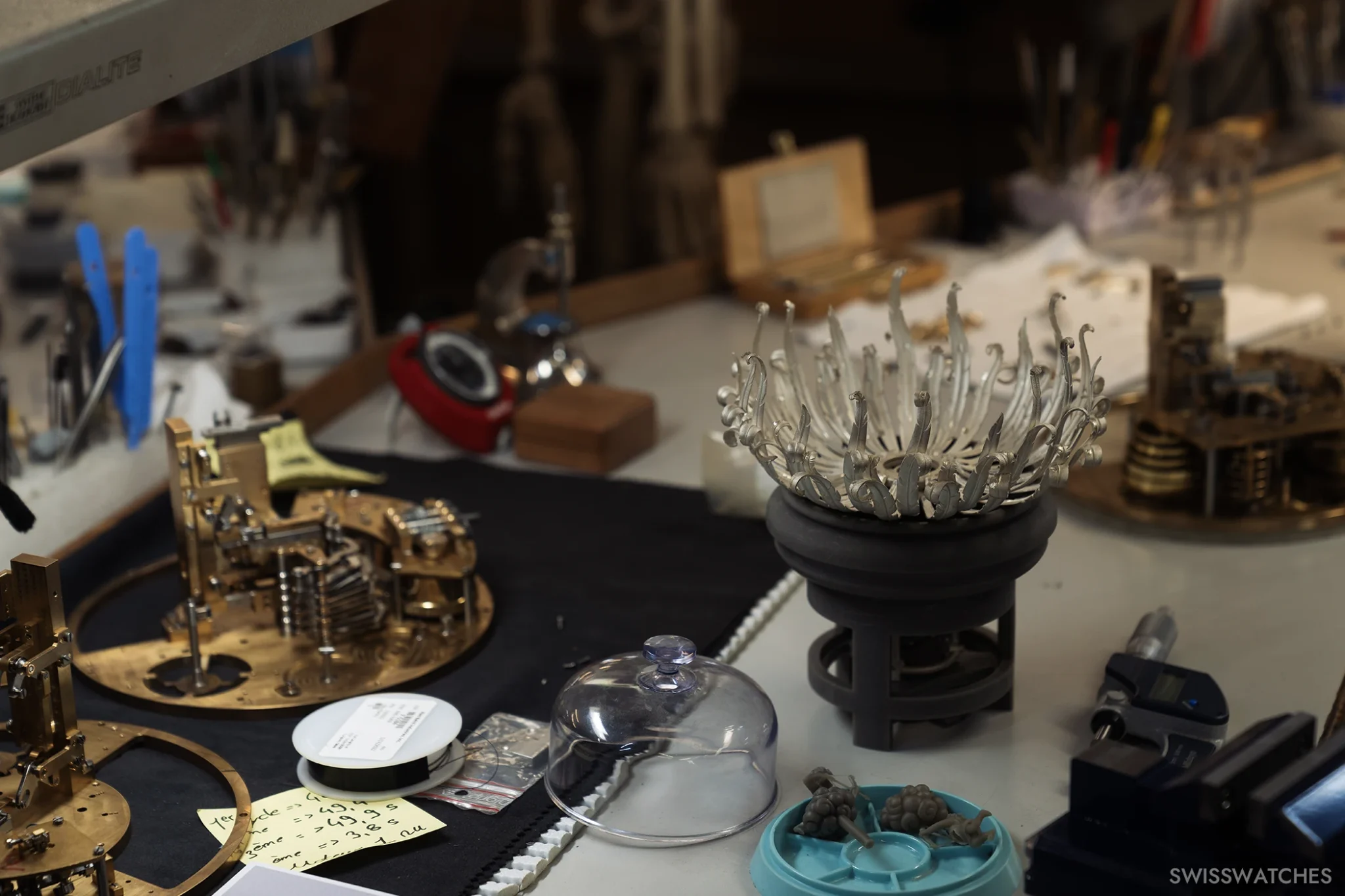
Star of the show: Planétarium automaton
Speaking of precious stones, it’s time to take a look at what will no doubt prove the star of the show over at the Van Cleef & Arpels stand: the Planétarium automaton. Alongside its fixation upon love and poetry, Van Cleef has long taken an interest in the stars and the celestial workings of the sky above. Throughout the last decade, the maison has been working to compress the dimensions of 19th century planetariums, mirroring the Sun, Moon, and planets, through complex timepieces and large-scale automata. This year brings a new model, equipped with its own unique combination of materials: rose-, white-, and yellow gold, rubies, lapis lazuli calcedony, pearl, jasper, jet, milky rose quartz, orange moonstone obsidian, lemon tree, ziricote, amaranth, white holly, glass, black and bronze PVD amongst others.
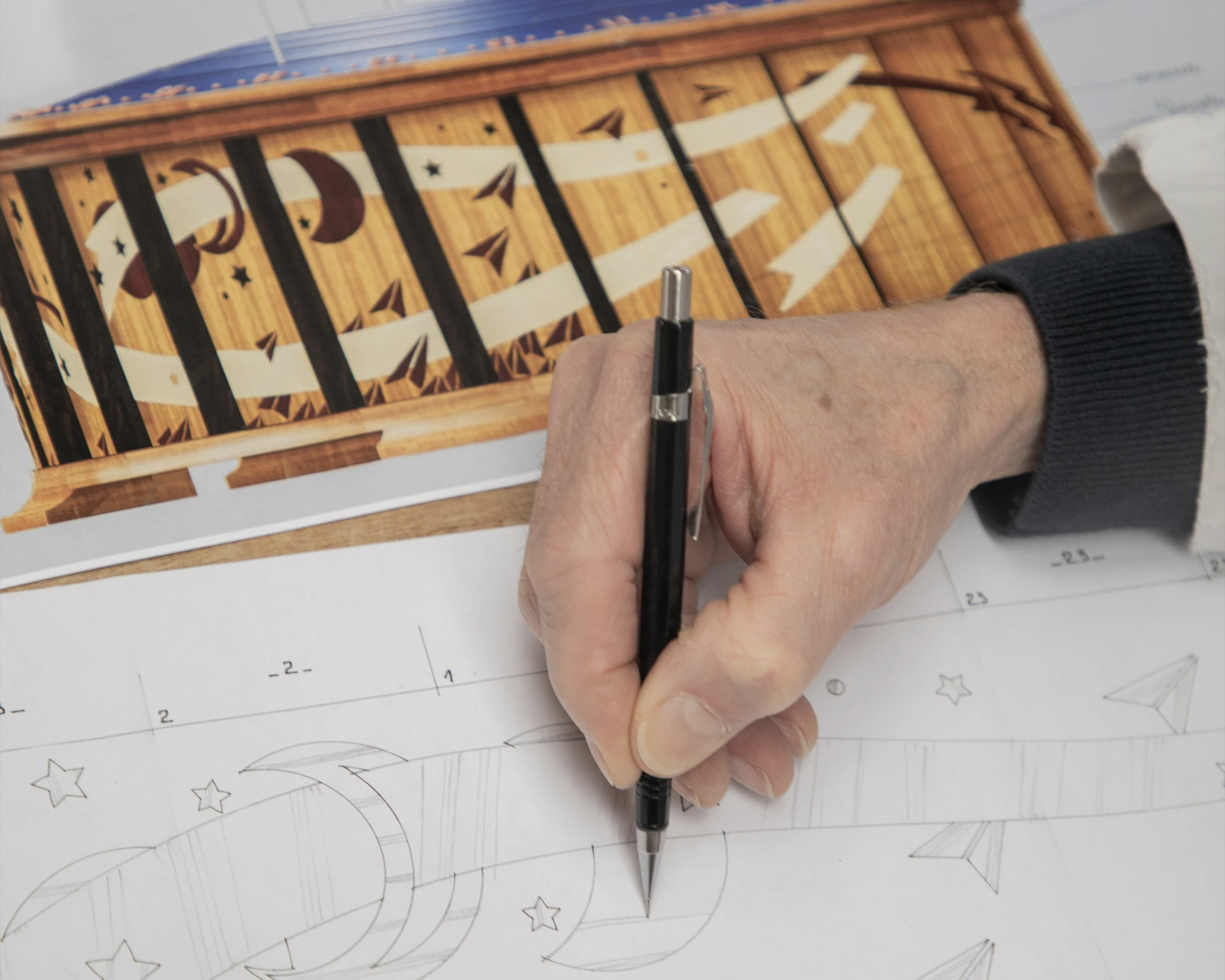
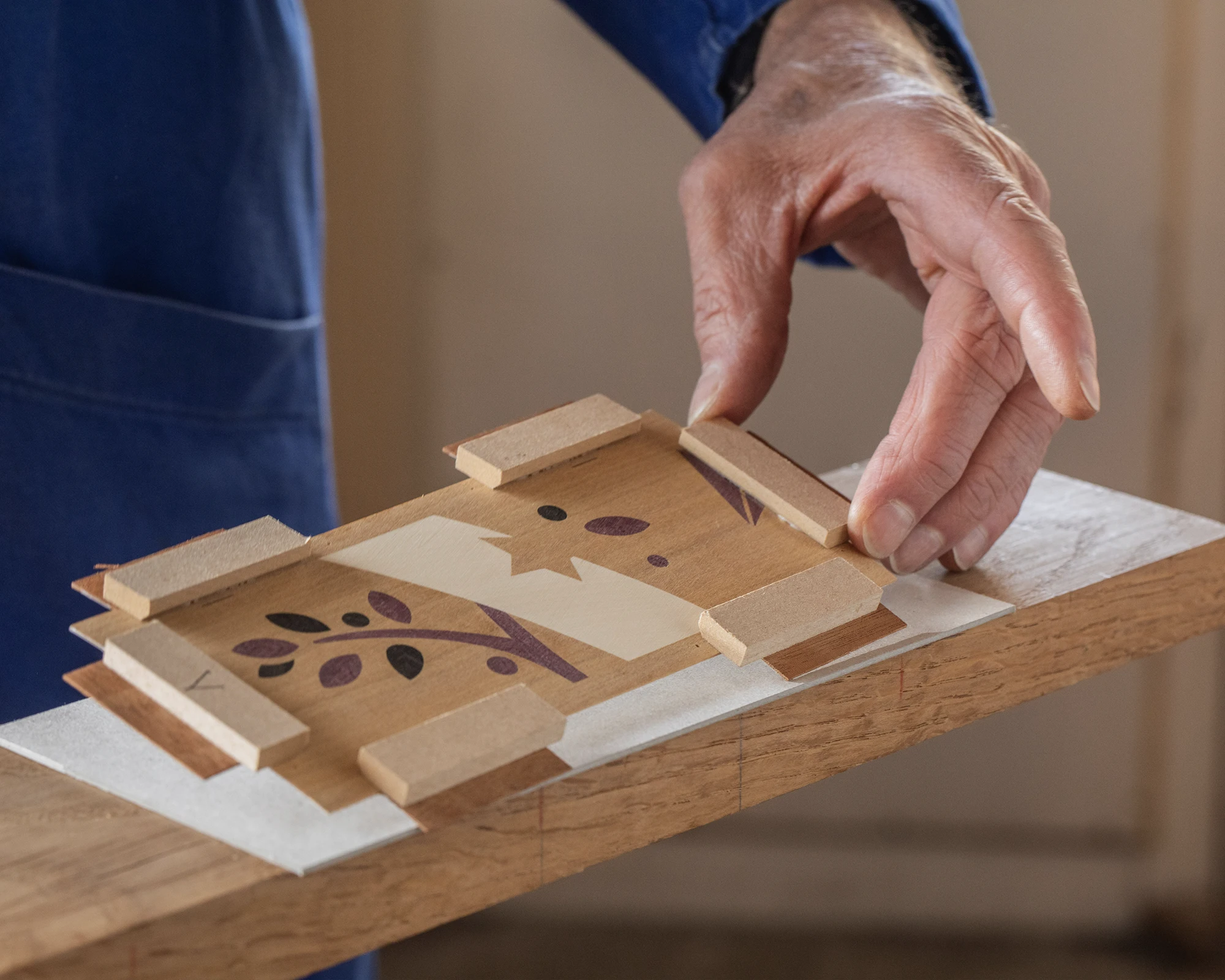
Precious stone planets
One particularly notable element is the Sun, featuring spessartite garnets, yellow sapphires and diamonds set on over 500 gold stems. The Sun mesmerizingly quivers thanks to an additional trembleur feature integrated into the automaton mechanism. As in the 20th century, the other planets feature 18th century-style ribbons adorned with the planet names. Numerous cultural references are also made within each planet through their design. Venus, for example, features tiny shells and appears in rose quartz with pink sapphires, while Mars is embellished with arrows and uses orange moonstone. Saturn opts for jet, and Jupiter features lightning bolts in combination with jasper.
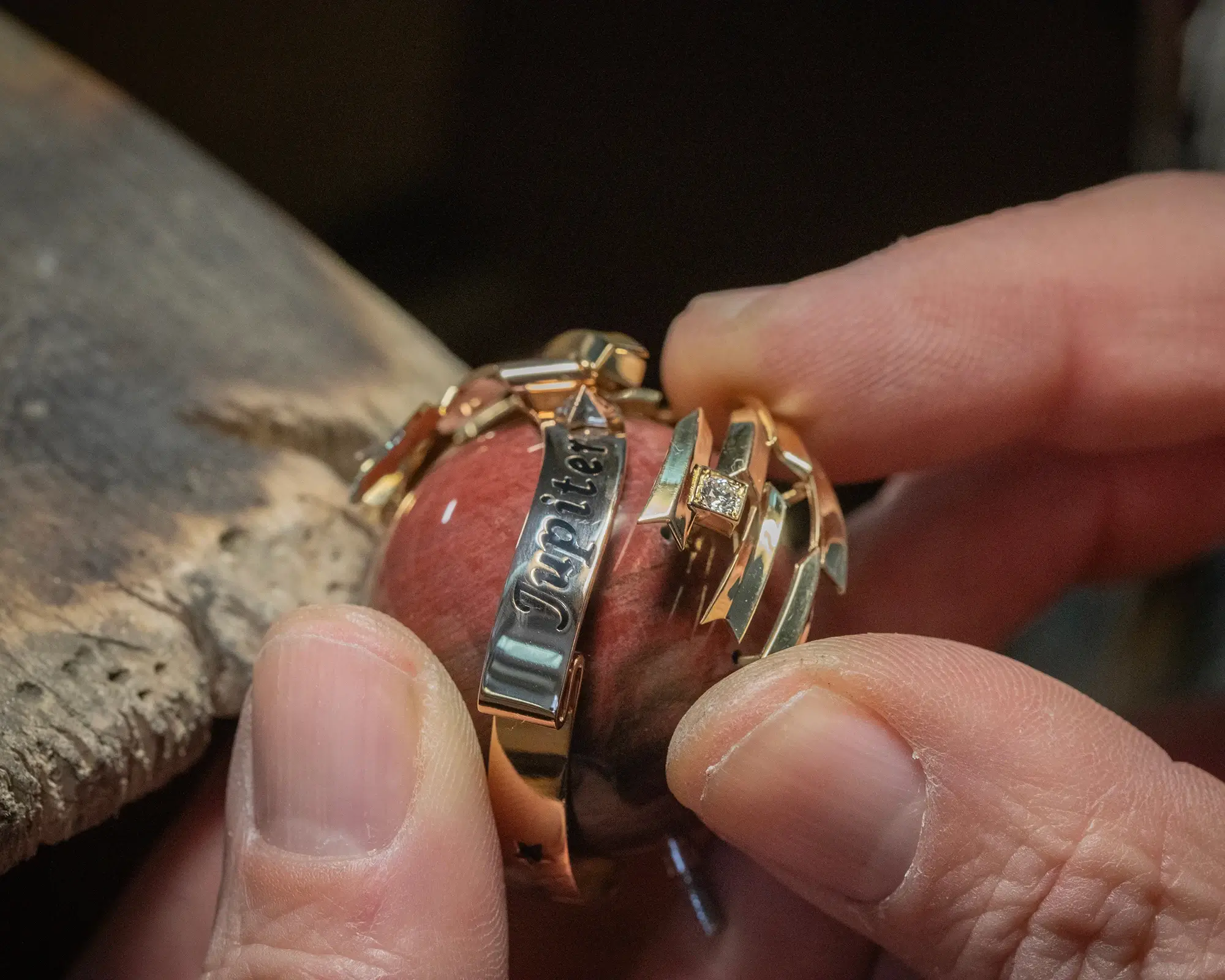
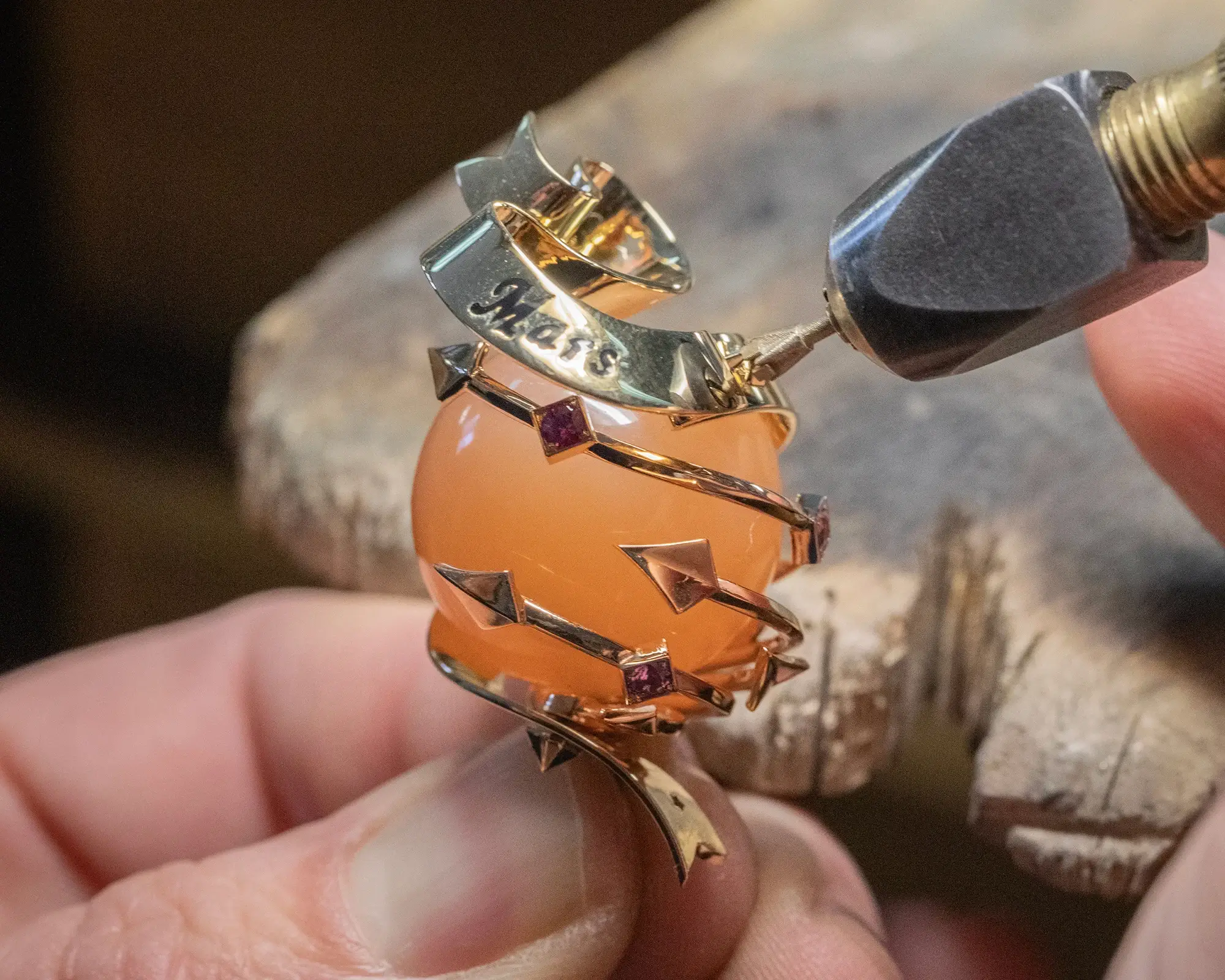
The largest of the creations at the Van Cleef & Arpels, the planetarium reaches 50 cm in height and 66.5 cm in diameter. And no wonder: it houses a complex mechanism which allows each planet to move in real time, meaning 88 days for Mercury, 224 days for Venus, 265 days for Earth, 676 days for Mars, and an impressive 11.86 years for Jupiter and 29.5 years for Saturn. Meanwhile, the Moon animates day by day, mirroring the 27.3 days it takes for the Moon to rotate around the Earth. In addition, an on-demand animation allows the owner to activate a dance of the starts. When the animation of the entire planetarium begins, a rose-gold shooting star, decorated with diamonds and ‘Mystery-set’ rubies emerge and fly to indicating the hours and minutes on a 24-hour dial. Once again, a delicate melody plays throughout, thanks to a 15-bell chime. These incredible bells, created in collaboration with external experts at a university in Germany, can also be admired in action via a door.

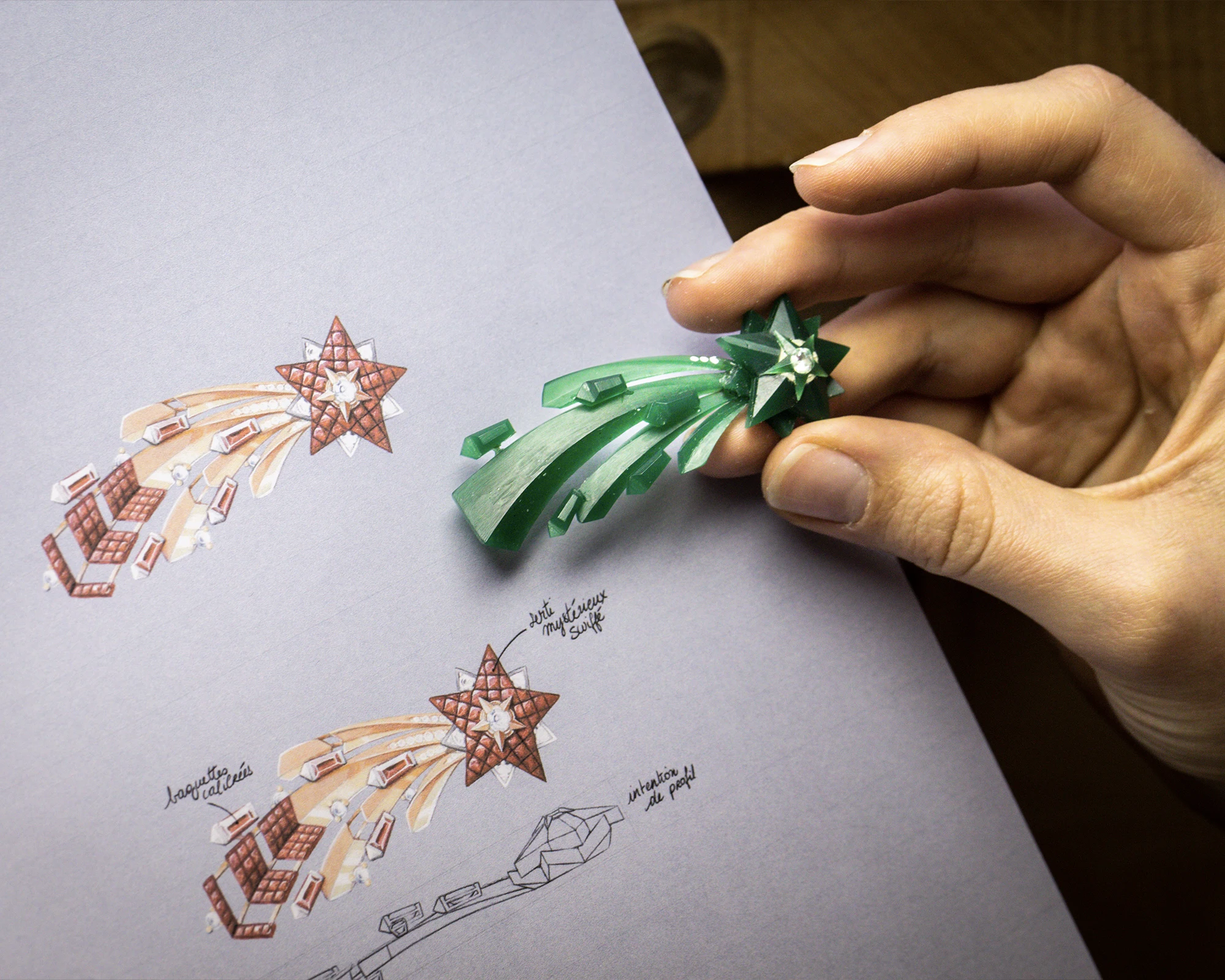
Automaton table clocks at Van Cleef
The tradition of automaton table clocks goes back to the 19th century, and in 2017, Nicolas Bos wanted to revive this heritage – not with the intent to sell, but to support craftsmanship in Paris and France. Thus, a unique piece was made and put on display in Paris. This would prove to be a catalyst, as a client insisted on purchasing it, consequently leading to the creation of a dedicated collection. In 2020, Van Cleef introduced the planetarium, the Fontaine aux Oiseaux, and other pieces. Since then, interest has grown significantly, and the future of these objects at Van Cleef & Arpels looks very promising.
The Ruban Mystérieux
Last but not least, we are treated to a jewellery watch unique piece, accompanying the gorgeous quartz-powered signature Cadenas novelties – and this jewellery watch is a mechanical one, no less. It’s also well worth taking a moment to appreciate the new miniature watch’s couture design. Imitating the shape of a ribbon, the design features an oval mother-of-pearl dial encircled by a 3.72-carat diamond. Indeed, diamonds take centre stage on the model, featuring a snow-set arrangement on the bracelet in combination with Van Cleef’s so-called ‘Mystery Set’ technique. A testament to Van Cleef’s longstanding expertise, this savoir-faire involves carefully cutting stones into gold rails.
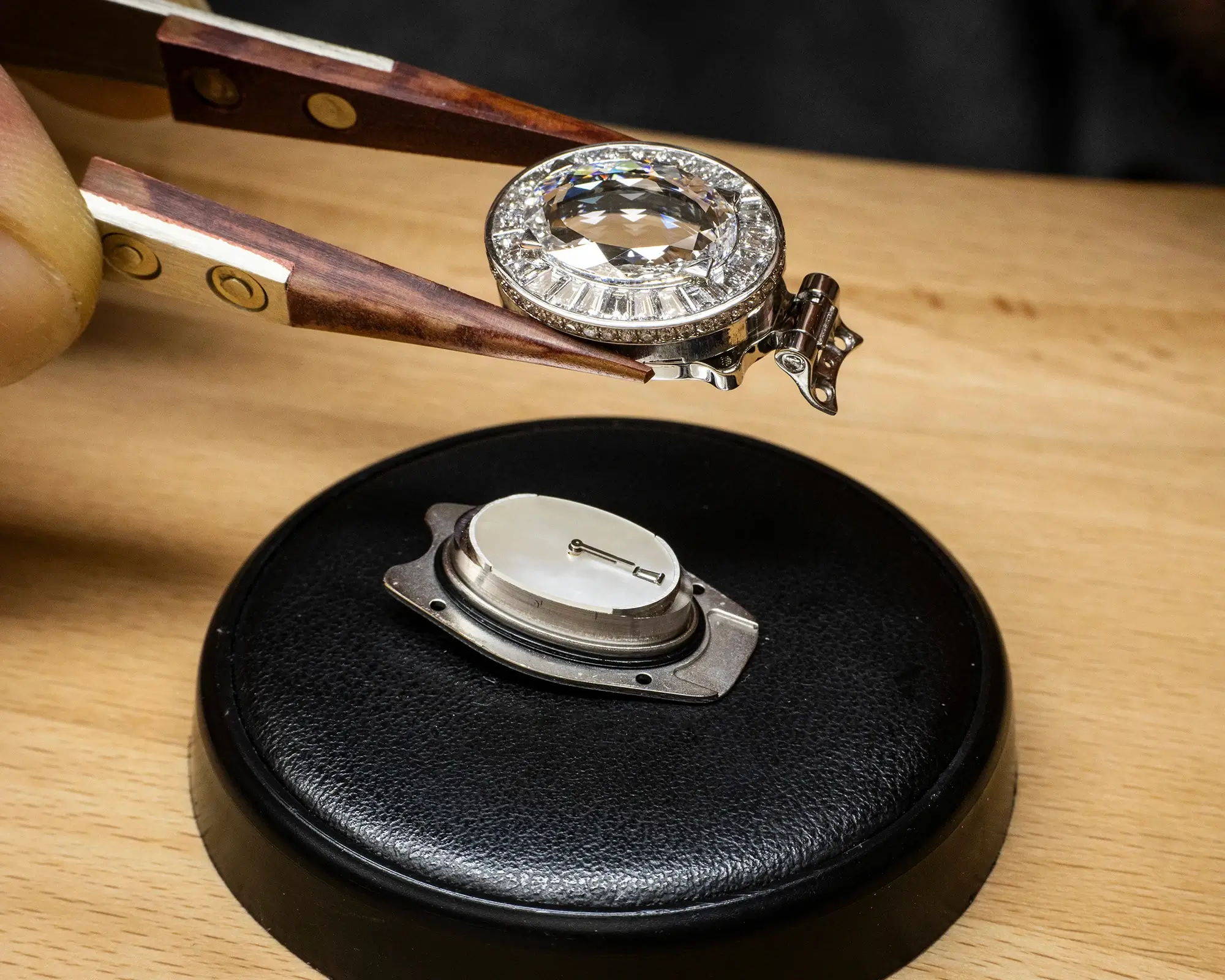
It’s a beautiful piece to round off another year of breathtaking novelties from the maison, which will mark its 120th anniversary next year. We wait with baited breath to see what the next year holds under the leadership of its new CEO, Catherine Rénier – and if it’s anything like we’ve seen at Watches and Wonders 2024, there’s plenty to look forward to.

